Turkey Next Handshake


Political Fiasco in Sudan: A Stale Crisis









The Iranian regime has reached new levels of depravity in its efforts to quell the unrest stemming from a young Kurdish woman’s murder at the hands of the state’s morality police in September.
For three months, major cities across Iran have seen demonstrations against the state, whose security organs have tried and failed to use repression to end them. The authorities must be truly fed up.
According to reports, Iran’s powerful and ruthless Islamic Revolutionary Guards Corps (IRGC) has started deploying more brutal tactics: abductions, mass arrests, sexual violence including rape against detained protesters, and the use of nerve agents such as hexachloroethane in several Kurdish cities.
In the Cover Story, Suzan Quitaz reviewed whether Tehran has plumbed new depths by using nerve gas, abductions, and rape to quell Kurd-led protests.
In the Politics Section, Dalia Ziada wrote about ties between Egypt and Turkey and how at the opening ceremony of the FIFA World Cup in Doha, Qatar’s Prince Tamim Bin Hamad scored one of his finest political goals by overseeing a historic handshake between the leaders of Turkey and Egypt.
Ziada said that the friendly encounter in Doha earlier this month between the Egyptian president, Abdel Fattah El-Sisi, and his Turkish counterpart, Recep Tayyip Erdogan, cannot be seen as a standard act of courtesy that happened out of sheer coincidence. It was the climax of a year of backstage arrangements in both countries and months of Qatar-led shuttle diplomacy.
In another Politics piece, Ahmed Taher talked about the situation in Sudan. He said that Sudan had its own share of what was called a decade ago an “Arab Spring,” which carried nothing but heavy storms that wreaked havoc on several countries. Some managed to overcome the crisis safely like Egypt, Morocco, Jordan and Bahrain. Other countries, meanwhile, are still facing some political challenges, like Tunisia.
However, the remaining countries have entered a dark tunnel, battling over power, as in the case of Syria, Libya and Yemen.
Taher said that amidst all these examples, Sudan emerges as a middle ground example combining two cases – living in a political crisis, accompanied by developments on the ground, with citizens taking to the streets from time to time when politics reaches a stagnating point due to the continuous struggle between the two sides of the authority, viz., the military and civil.
In the Economy Section, Salwa Samir writes about Egyptian gains from the Russian-Ukrainian war. She said that the energy crisis in Europe is what some considered the only Egyptian gain from this war.
Egypt is one of the natural gas producing countries and also generates electrical energy as a result of its reliance on renewable energy sources from the sun and wind.
Egyptian Prime Minister Mostafa Madbouly said in a recent cabinet meeting that Egypt has an exceptional opportunity during the coming winter to attract the largest possible number of tourists, in light of the current global crisis.
Read these articles and more on our website eng.majalla.com. As always, we welcome and value our readers’ feedback and we invite you to take the opportunity to leave your comments on our website.
A Weekly Political News Magazine www.majalla.com/eng
Editor-in-Chief
The Editor Mostafa El-Dessouki


10th Floor Building 7 Chiswick Business Park 566 Chiswick High Road London W4 5YG
Tel : +44 207 831 8181Fax: +44 207 831 2310









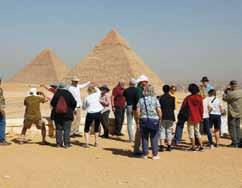


A woman takes photo of the painting by Ukrainian artist Vik� tor Palmov called ‹The 1st of May› during the inauguration of the Ukraine art exposition at the Thyssen Bornemisza museum in Ma drid, Spain, Monday, Nov. 28, 2022. /AP





Sharjah exhibition at the Museum of Arts


A person observes the Sharjah exhibition at the Museum of Arts (MUSA), within the framework of the 36th edition of the Guadala jara International Book Fair, in Guadalajara, Jalisco state, Mexico, 25 November 2022./ EPA


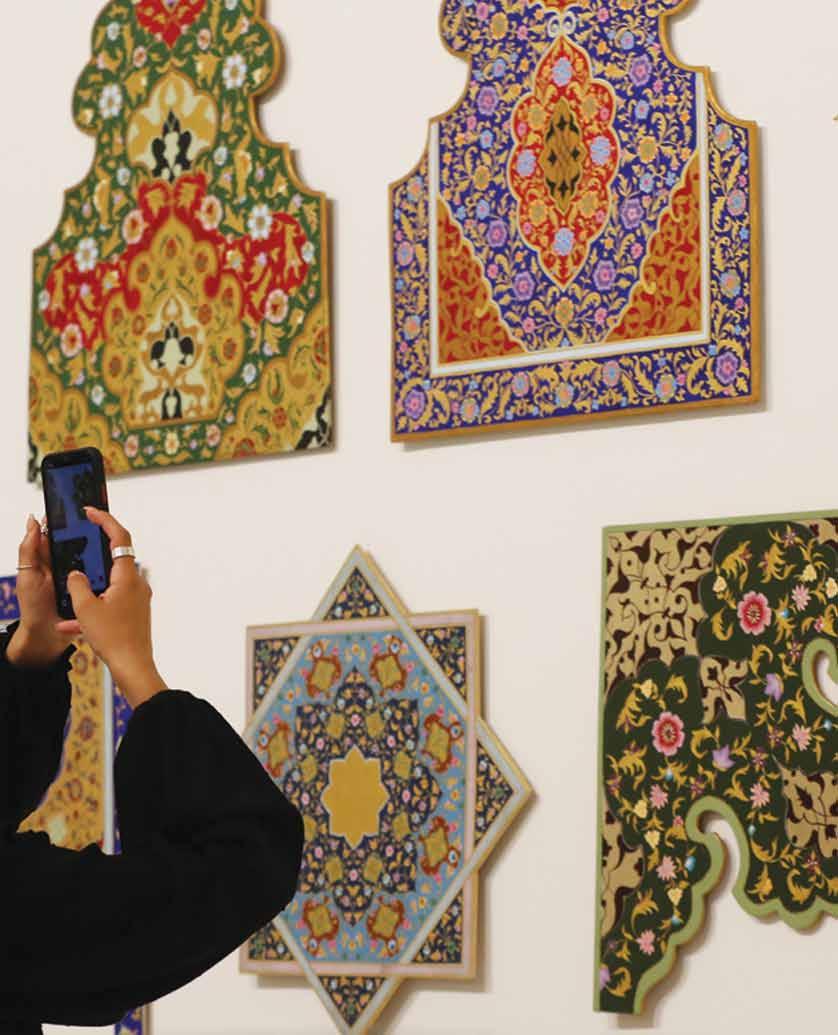

Egypt plans to award deals next year to build 21 water desalination plants in the rst $3 billion phase of a program that will draw on renewable energy, the CEO of the country's sovereign fund said on Thursday. Egypt, which recently hosted the COP27 U.N. climate talks and is trying to boost investment in renewables, also aims to start production on its green hydrogen projects in 2025-2026, Ayman Soliman told the Reuters NEXT conference.
The government's water desalination program aims to generate the production of 3.3 million cubic meters of desalinated water daily in the rst phase, and eventually reach 8.8 million cubic meters daily.

The Biden administration on Thursday slapped terrorism sanctions on two accountants and two companies in Lebanon for providing the militant group Hezbollah with nancial services. The Treasury Department announced it would also impose sanctions on a third person for assisting Hezbollah, a U.S.-designated “foreign terrorist organization,” with weapons acquisitions.
The penalties target Adel Mohamad Mansour, executive director of Hezbollah’s al-Qard Al-Hassan group, which has been previously sanctioned by the U.S., as well as another company he is involved with, al-Khobara for Accounting, Auditing, and Studies.

Saudi Arabia summit on President Xi kingdom, three familiar with Xi is scheduled two of the with direct that comes relations that over energy growing Chinese Invitations Middle East Chinese-Arab

Arabia plans to host a Chinese-Arab Dec. 9 attended by Chinese Xi Jinping during his visit to the three Arab diplomats in the region with the plans said. scheduled to arrive in Riyadh on Dec. 7, diplomats and the fourth source knowledge of the visit said, on a trip at a sensitive time for Saudi-U.S. that have been strained by a dispute energy supplies and concerns over Chinese in uence in the Middle East. have gone out to leaders in the East and North Africa for the Chinese-Arab gathering, the diplomats said.

Yemen’s internationally recognized government signed a deal with the Arab Monetary Fund on Sunday, state media said, paving the way for the Saudi-backed administration to receive $1 billion of economic aid.

Evidence collected in Iraq strengthens preliminary ndings that Islamic State extremists committed crimes against humanity and war crimes against the Christian community after it seized about a third of the country in 2014, a U.N. investigative team said in a report circulated Thursday. The report to the U.N. Security Council said crimes included forcibly transferring and persecuting Christians, seizing their property, engaging in sexual violence, enslavement and other “inhumane acts,” such as forced conversions and destruction of cultural and religious sites.
A U.S. push for Iran to be removed from a U.N. women's equality and empowerment body will be voted on Dec. 14, diplomats said as Washington lobbies for Tehran to be punished over its denial of women's rights and brutal crackdown on protests. The United States on Monday circulated a draft resolution on the move, seen by Reuters, that also denounces Iran's policies as " agrantly contrary to the human rights of women and girls and to the mandate of the Commission on the Status of Women."


U.S. President Joe Biden said he has no immediate plans to contact Vladimir Putin but is prepared to speak with the Russian president if he shows an interest in ending the war in Ukraine, and only in consultation with NATO allies.
"I have no immediate plans to contact Mr Putin," Biden said at a White House news conference after talks with French counterpart Emmanuel Macron. "I'm prepared to speak with Mr. Putin, if in fact there is an interest in him deciding he's looking for a way to end the war. He hasn't done that yet."
Cuba has denied that its coast guard vessel was to blame for a collision with a migrant-packed boat that led to the deaths of seven people, including a two-year-old girl, saying the migrant boat made an abrupt turn in heavy swells that caused the crash. The boat was headed to the United States when it ipped over in October after the crash near Bahía Honda, about two hours from the capital of Havana. The boat, which was made to hold six people, was carrying up to 26, according to state media CubaDebate and CubaVision, which gave a details of the government’s version of events this week.
,
Tunisians celebrated a historic but bittersweet World Cup victory over France as they defeated their former colonial power but still crashed out of a tournament marked by a remarkable string of Arab wins over football powerhouses.
Car horns sounded in Tunis after the nal whistle in Tunisia’s 1-0 win as fans savoured the moment even though their side did not make it through to the last 16 of the Qatar World Cup, the rst in an Arab country.
over win an
Finnish Prime Minister Sanna Marin on Friday o ered a "brutally honest" assessment of Europe's capabilities in the wake of Russia's war on Ukraine, stating bluntly that "we're not strong enough" to stand up to Moscow alone.
Visiting Australia, the leader of the pending NATO member said Vladimir Putin's invasion and occupation of neighbouring Ukraine had exposed both European weaknesses and strategic blunders in dealing with Russia.
"I must be very honest, brutally honest with you, Europe isn't strong enough right now. We would be in trouble without the United States," she told Sydney's Lowy Institute think tank.
India o cially takes up its role as chair of the Group of 20 leading economies for the coming year Thursday and it’s putting climate at the top of the group’s priorities.
China is set to announce an easing of its COVID-19 quarantine protocols in the coming days and a reduction in mass testing, sources told Reuters, a marked shift in policy after anger over the world's toughest curbs fueled widespread protests.
Cases nationwide remain near record highs but the changes come as some cities have been lifting their lockdowns in recent days, and a top o cial said the ability of the virus to cause disease was weakening. Health authorities announcing the easing in their areas have not mentioned the protests - the biggest show of civil disobedience in China for years - which ranged from candle-lit vigils in Beijing to street clashes with police in Guangzhou.
If the latest claims are to be believed, the Iranian re gime has reached new levels of depravity to quell the
unrest stemming from a young Kurdish woman’s mur der at the hands of the state’s morality police in Sep tember. For three months, major cities across Iran have seen demonstrations against the state, whose security
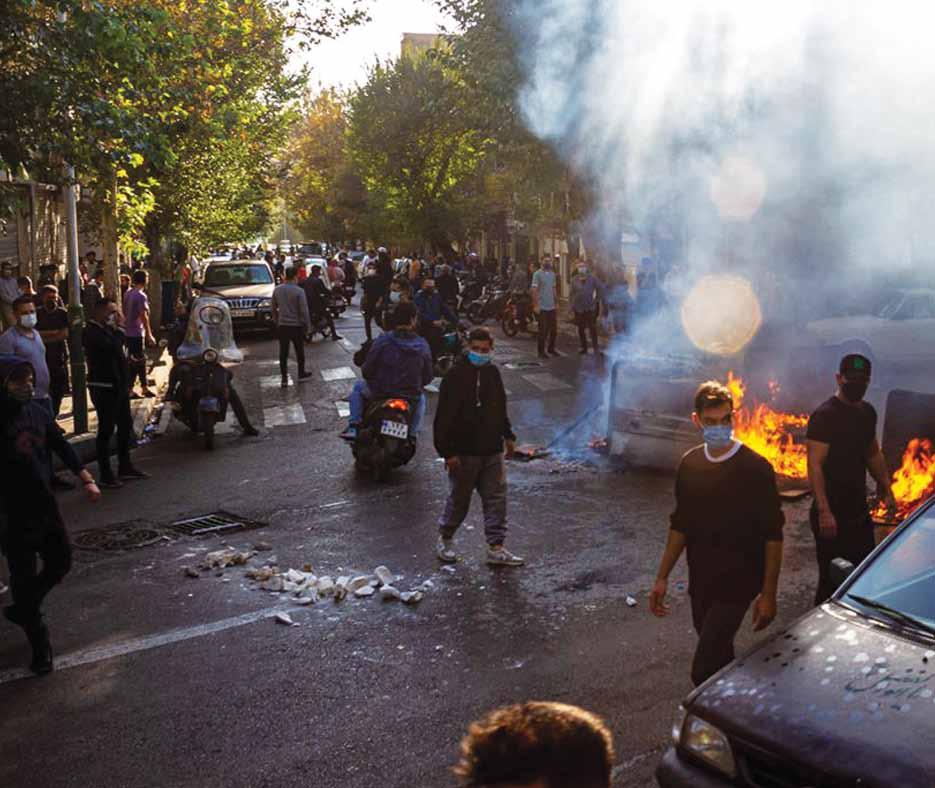
Iranian protests over the death of Mahsa Amini have carried on for more than a month in Tehran, October 2022 ,27.

organs have tried and failed to use repression to end them. The authorities must be truly fed up.
According to reports, Iran’s powerful and ruthless Islamic Revolutionary Guards Corps (IRGC) has started deploying more ruthless tactics: abduc tions, mass arrests, sexual violence including rape against detained protesters, and the use of nerve agents such as hexachloroethane in several Kurd ish cities.
The brutality of all this (against unarmed protest ers) seems to have changed the shape of resist ance in some part of Iran, at least in the level of intensity. Reports from Persian-majority cities such as Tehran suggests that there are now fewer mass protests and more ‘flash mobs’ and/or civil disobedience, such as people shouting from their
windows: “Death to the Dictator”. The picture looks very different elsewhere, with continuing protests in Iran’s Kurdish region of Rojhalet.
Since its inception in 1979, the Islamic Republic has repressed its ethnic minorities - Kurds in the West, Baluchis in the southeast, Sunni Arabs in Ahvaz in the south. In these areas, the regime fac es an acute challenge, with anti-Tehran protests and a growing armed resistance steadily intensi fying.
Rojhalet protest organisers have called on the people of Iran to take part in mass nationwide pro tests 24-25 November in solidarity with Kurds, who may well be under threat like never before, after videos emerged on social media allegedly showing Iranian security forces using a “thick green gas” nerve agent against demonstrators in the Kurdish-majority cities of Javanrud, Kerman shah and Piranshahr.
Even more disturbingly, there are also videos showing security forces sexually assaulting fe male protesters on the streets, which now get filed alongside unverified reports of rape against female and male protest detainees, including mi nors.
Speaking to Majalla, Rebaz Sharifi of the Kurd istan Freedom Party Leadership Council (PAK) said the repression was further spread. “Not only in these cities of Javanrud, Piranshahr, Sanaa and Kermanshah was this brutality committed,” said Sharifi. “Dozens were martyred and thousands injured in one week. Many have been arrested and are now missing. Some were killed and their bodies dumped on the outskirts of the city. Night
For three months, major cities across Iran have seen demonstrations against the state, whose security organs have tried and failed to use repression to end them.
forces raid houses to arrest and take away boys and girls… Rifles and machine guns are now be ing used to kill people.”
Asked about the use of hexachloroethane gas (HCE) against Kurdish civilians, Sharifi said: “Yes, they used a kind of gas in Mahabad and Javanrud, which causes headaches and disorders.” He also accused Iranian security forces of using sexual violence including rape to suppress pro tests.
The Hengaw Organisation for Human Rights is a
Norwegian NGO operating in Iran’s Kurdish re gion said they “received reports of using strange gas by security forces, but until now we couldn’t confirm the type of gas was used by those forces”. Some say the gas used in Javanrud and Piranshahr is HCE. Others say it is adamsite, an organic com pound used as a riot-control agent.
US-based physician Dr Mohammad-Kazem Atta ri told the London-based Iran International Chan nel that HCE is used widely in open-air military exercises but unlike the extremely toxic Sarin, VN, and other nerve gases, it does not cause death or permanent disabilities, but rather serious skin irritations, partial paralysis of facial muscles etc. HEC has been banned by the European Commis sion since June 2003.
Reports of Iran using nerve agents on Kurds has sent shockwaves throughout the country and re kindled memories of Halabja, the Kurdish city in Iraqi Kurdistan, which was attacked on 16 March 1988 by Saddam Hussein, with 5,000 killed with in minutes another 7,000-10,000 left suffering life-long health problems.
Hengaw said 118 Kurds had been killed by Ira nian security forces in the past three month, with
Iranians protest a 22-year-old woman Mahsa Amini’s death after she was detained by the morality police in Tehran, Sept. 20, 2022. (AP Photo/Middle East Images)

“Dozens were martyred and thousands injured in one week. Many have been arrested and are now missing. Some were killed and their bodies dumped on the outskirts of the city.”
Iranians protest the death of 22-year-old Mahsa Amini in Tehran on Thursday. Ms. Amini died after she was detained by the morality police. AP Photo

more than 5,000 detained. It also reported that from 15-21 November at least 42 Kurds were killed by direct fire from the Iranian forces, with 1,500+ injured. The charity said it believes that there is “definite evidence regarding genocide” in the last 48 hours in the cities of Kurdistan, with an emphasis on Javanrud.
are massacres against civilians,” it said. “Govern ment forces deliberately shot at protesters on the streets of Mahabad, Javanrud, Bokan, and other cities in Kurdistan. They also fire at civilian hous es… 118 Kurdish citizens were killed in the pro tests. There are more deaths that are not published by the families of the victims due to the pressure from the security forces. Many citizens are miss ing in Kurdistan and their fate is unknown.”
There is solidarity with the Kurdish people. In Baluchistan, in the city of Zahedan, a large crowd gathered to chant: “We stand with Rojhalet”. In Tehran, demonstrators gathered at night to chant: “Mahabad, Kurdistan, the role model of whole Iran”. It comes amid fears that the Iranian regime is set to commit large-scale massacres in Kurdish regions.
They have cause to worry. On 21 November, Tas nim News Agency, an Iranian regime mouthpiece, reported that IRGC forces were clearing cities of anti-regime elements. The majority of these cities were in ethnic-minority regions in Baluchistan, Azerbaijan province, including many Kurdish cities such as Ilham, Saqqez (hometown of the murdered Zhina Amini), Bokan, and Mahabad. Iran’s Supreme Leader Ali Khamenei has given

“We believe what is happening in Kurdistan cities
his blessing to the IRGC crackdown.
This is counter insurgency tactics, not protestmanagement. Indiscriminately firing at civilians, cutting and isolating cities by blocking major roads – these are not from any standard text book. Last week, IRGC commander Mohammad Pakpour identified the Kurdistan Freedom Party (PAK) as the main cause of the “riots and cha os” and threatened further attacks. In the city of
Bokan, IRGC units have allegedly been driving round chanting: “I swear on crushing the demon strations.” Activists say this is an explicit call for more violence against the Kurdish people.
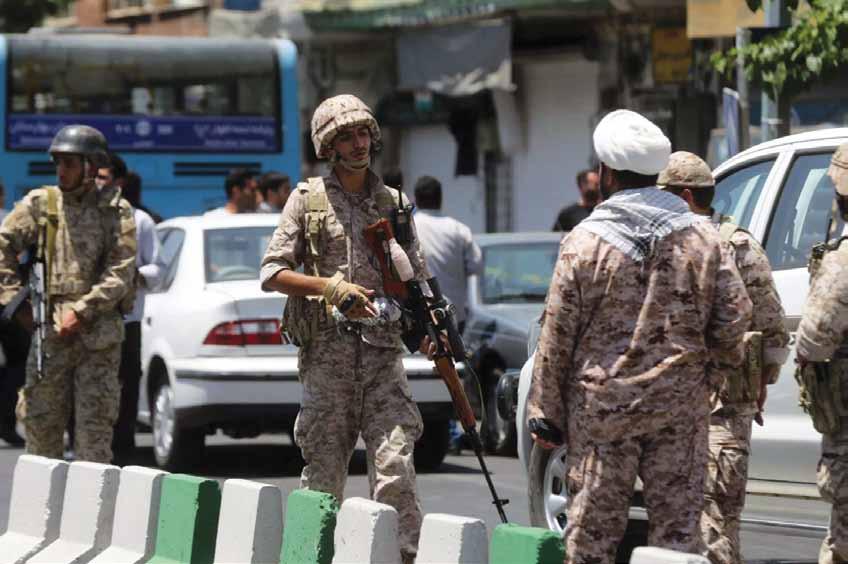
All this suggests that the regime has lost control at least in some parts of Rojhalet, and sees the continue protests as an acute threat to its very survival. Responding to Pakpour’s threat, Sharifi said: “We have been under threat and terrorism from the Iranian state for 43 years. No threat or behaviour will deter us from the struggle for free dom. We are in a war between freedom and the war of the donkey. Kurdistan Freedom, PAK, is the source of the Kurdistan nation. It’s their party, of the nation of the people and Kurds. The party is fighting for their rights and goals. PAK supports the uprising and is with the uprising. We will pay the price for this position and we do not care about any threat… No matter how many threats there are, they will not stop us from fighting for freedom.”
Sharifi added that “many of our Peshmerga fight ers lost their lives, many of our Peshmerga bases
Reports from Persian-majority cities such as Tehran suggests that there are now fewer mass protests and more ‘flash mobs’ and/or civil disobedience, such as people shouting from their windows: “Death to the Dictator”.Members of the Iranian Revolutionary Guard secure the area outside the Iranian parliament during an attack on the complex in the capital Tehran on June 7, 2017. Hossein Mersadi/AFP/ Getty Images
A newspaper with a cover picture of Mahsa Amini, a woman who died after being arrested by Iranian morality police is seen in Tehran, Iran, Septem ber 18, 2022. Majid Asgaripour/WANA (West Asia News Agency) via REUTERS

were destroyed against the battlefield against ISIS… It is the duty of the United States and the international coalition to protect the airspace of the Kurdistan Region and counter Iranian aggres sion against the Peshmerga”.
Sharifi said the PAK had so far not deployed any Peshmerga fighters but said protesters had a natu ral right to defend themselves. The regime has killed many unarmed protesters from Day 1, he said, adding: “The military attack on the cities of Kurdistan is organised, widespread, and pro grammed for the specific purpose of killing the Kurds.” He does not rule out protesters taking up arms. On 26 November, the PAK reported that the IRGC deployed heavy artillery against Kurd ish cities in Rojhalet, saying it was designed to “suppress and kill peaceful protesters”.
Irrespective of whether there is an international response, we are approaching a turning point: the protests are ongoing, and the regime has failed to quell them, but the level of barbarity in recent weeks shows that the Mullahs are running out of patience. They should be. This remains a big mo ment for the country. For first time since 1979,
the people of Iran united against the regime. Yes, Kurds have borne the brunt of the backlash, and Iranian troops have been deployed to Kurdish cit ies. It is only a matter of time before troops get their final order: eliminate the final protesters.
Sharifi urges the US and others to “hear the voice of the Kurds and the revolting people of Iran”, say ing: “It is time for the free world to support the ac tions of the Kurds and all the people of Iran to end the Islamic Republic. We call on the United States and other major countries to declare a no-fly zone in East Kurdistan. This will both prevent further killings and create more opportunities for freedom uprisings to continue elsewhere in Iran.”
“It is time for the free world to support the actions of the Kurds and all the people of Iran to end the Islamic Republic.”

At the opening ceremony of the FIFA World Cup in Doha, Qatar’s Prince Tamim Bin Hamad scored one of his finest political goals by overseeing a historic handshake between the leaders of Turkey and Egypt. The friendly encounter in Doha earlier this month between the Egyptian president, Abdel Fattah El-Sisi, and his Turkish counterpart, Recep Tayyip Erdogan, cannot be seen as a standard act of cour tesy that happened out of sheer coincidence. It was the cli max of a year of backstage arrangements in both countries and months of Qatar-led shuttle diplomacy.
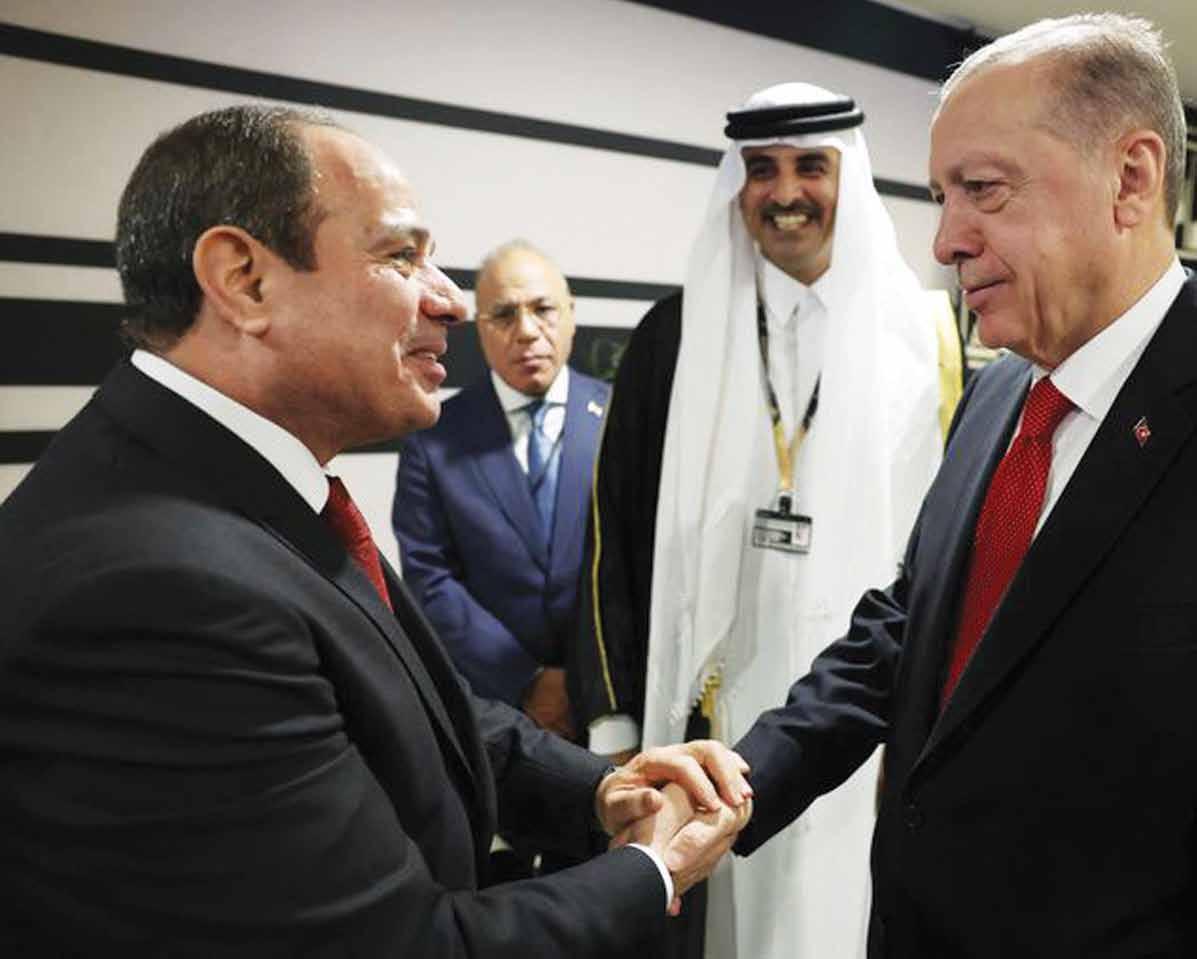
The importance of the momentous meeting between the leaders of Turkey and Egypt, which lasted for 45 minutes, does not stop at the threshold of melting away the personal prejudices that incited nine years of heated diplomatic tensions and state-sponsored media wars. This encounter marks a turning point in the bilateral ties between the two states. Yet, most important is its impact on the geopolitical and geoeconomic future of the Middle East and the Eastern Mediterranean. On another level, it reframes Qatar in a whole new positive light as an active peacemaker and agenda-setter in the Arab Gulf region and be yond.
Since its successful reconciliation with Egypt in 2021, the Qatari leadership has been determined to fix the rift between Egypt and Turkey. This coincid ed with a sincere desire by the Turkish state to end conflicts with Arab and non-Arab neighbors in the Middle East. Over the past year, Turkey restored its broken ties with Saudi Arabia, the United Arab Emir ates (UAE), and even Israel. Meanwhile, Egypt and Qatar successfully rebuilt their bond of trust as sis terly countries by fostering economic and diplomatic cooperation.

The conflict between Egypt and Turkey was not as intense as the conflict between Turkey and the Gulf states or as was the conflict between Egypt and Qa tar. Despite that, the reconciliation process between Egypt and Turkey, which started in May 2021 with limited diplomatic talks in Cairo and Ankara, has been progressing at a snail’s pace. That is mainly be cause the heads of the two states have been avoiding each other out of fear of the public’s reaction in their respective countries, which has been fueled by the rhetoric of hate and anger for years. The recent meet ing between El-Sisi and Erdogan is believed to have accelerated the process of diplomatic rebounding in the near future.
Mending the broken ties between Egypt and Turkey is the last missing piece of the puzzle for forming “the coalition of odds” that is believed will be leading the future of the Middle East for decades to come. In 2020, the term “coalition of odds” was coined by the writer of this analysis to refer to the new alliance of regional powers that has been forming under the pres sure of international crises and regional challenges over the past few years.
This new alliance is mainly a quartet coalition of Saudi Arabia, Qatar, Turkey, and Egypt. Each pair
of these four countries stands at opposite spots on the spectrum of national strategic goals. However, each of them represents a crucial cornerstone of geo politics, geo-economics, and military supremacy that, when integrated, will comprise a mosaic of power that has never been seen before in the greater region of the Middle East and the Eastern Mediterranean.
Together, this quartet of odds can contain Iran and mitigate the threats constantly raised by its militia. They can dominate the flow of world trade movement across the Red Sea and the Mediterranean thanks to their unique geographic locations and economic out reach in Asia, Europe, and Africa. It is also need less to mention their collective dominance over the majority of the world’s energy resources, including fossil fuel, hydrocarbon extraction, and green energy resources. Above all, they can form an unbeatable regional military coalition enhanced by the NATO experience that Turkey enjoys and the massive per sonnel and armament capabilities of Turkey, Egypt, and Saudi Arabia.
Economic cooperation could be an ideal starting point for accelerating the process of rebuilding TurkishEgyptian relations. In complete contrast to the diplo matic impasse that kept Egypt and Turkey apart for almost a decade, commercial trading between them has been steadily growing. This year marked an un precedented increase of 32.6% in the volume of trade between the two countries, compared to last year, ac cording to the estimates of the Egyptian Chamber of Commerce.
According to the latest statistics by the Egyptian gov ernment, during the first quarter of 2022, Egyptian exports to Turkey grew by 178.9% (960.6 million dollars) from 537.1 million dollars at the beginning of 2021 to 1.4 billion dollars at the beginning of this year. In comparison, the volume of Turkey’s exports
Since its successful reconciliation with Egypt in 2021, the Qatari leadership has been determined to fix the rift between Egypt and Turkey.Turkey’s President Tayyip Erdogan shakes hands with his Egyptian counterpart Abdel Fattah el-Sisi on the sidelines of the World Cup in Doha, Qatar, November 20, 2022. Murat Cetin muhurdar/PPO/Handout via REUTERS
to Egypt increased from 3.31 billion dollars in 2020 to 3.94 billion dollars in the first quarter of 2022. Over the past 25 years, Egypt’s exports to Turkey have been steadily increasing by 9.63% each year, compared to a 10.2% annual increase in Turkey’s ex ports to Egypt.

Since the last quarter of 2021, Turkey has begun to receive, for the first time, cargos of liquified natural gas (LNG) from Egypt’s Idku and Damietta offshore plants in the eastern Mediterranean. The geographic proximity between the two countries made the trans fer of liquified gas a breeze in terms of speed and shipping costs. That should encourage the two coun
tries to consider combining forces to combat the on going global energy crisis.
Turkey is situated at the southern gates of Europe and close to the North African countries that produce massive amounts of oil and gas, such as Libya and Algeria. Turkey also represents the adjoining entry point for the liquified natural gas coming from Egypt and Israel through Egypt’s natural gas liquefaction plants to be exported to Europe. If the two countries agree to work together in that regard, they will not only solve the global energy crises but will dramati cally lift up their struggling economies.
However, for this to happen, Turkey and Egypt need to clear the air about their conflicting eco nomic and defense policies in the Eastern Medi terranean. Obviously, Egypt will not be able to back down from its Exclusive Economic Zone (EEZ) agreement signed with Greece in 2020. Yet, this should not prevent Egypt from conven ing similar agreements with Turkey. Meanwhile, the time has come to give Turkey access to the East Med Organization, given the fact that it is the country with the longest border in the Eastern Mediterranean, regardless of its never-ending con flicts with Greece.
Logically speaking, it is in Egypt’s best interest not to get involved in the century-long conflict between
Turkey still supports the Tripoli-based government against the parliament, while Egypt is a staunch supporter of Khalifa Haftar’s forces in the eastern territories.
Turkey and Greece or to side with one party against the other. It is needless to mention that Egypt is set to harvest more lucrative benefits from a maritime agreement with Turkey than it can have from agree ments with other countries on the northern side of the Mediterranean.

Consequently, that brings up the issue of Turkey’s and Egypt’s involvement at opposite fronts in the conflict in Libya. In addition to diplomatic talks, Egyptian and Turkish military leaders need to sit together to address the Libyan conflict, which each of them sees as integral to their national se curity. The Egyptian state is still concerned about the continued existence of Turkish troops on Lib yan soil.
Turkey still supports the Tripoli-based government against the parliament, while Egypt is a staunch sup porter of Khalifa Haftar’s forces in the eastern ter ritories. Egypt considers this a threat to its national security, despite the insistence of the Turkish state that the troops in Tripoli are only there to preserve the balance of power and prevent the eastern militia from taking over the government.
In a televised interview last week, Turkey’s
President Erdogan highlighted that his meeting with the Egyptian president was fruitful and left them “very happy.” But this is not enough. De spite its significant symbolism, the meeting be tween El-Sisi and Erdogan is merely the begin ning of a series of serious negotiations that need to happen between the Egyptian and the Turkish states. The next handshake should not be limited to the diplomatic channels, especially given their record of failing to achieve real progress on that issue for an entire year. Direct communications between the two presidents, consultations be tween the intelligence bureaus of both countries, and, above all, military-to-military talks could be way more effective in realizing a successful reconciliation between Turkey and Egypt that is set to last for a long time on the solid ground of realistic visions.
Economic cooperation could be an ideal starting point for accelerating the process of rebuilding Turkish-Egyptian relations.

Sudan had its own share of what was called a decade ago an “Arab Spring,”, which car ried nothing but heavy storms that wreaked havoc on several countries. Some managed
to overcome the crisis safely like Egypt, Morocco, Jordan and Bahrain. Other coun tries, meanwhile, are still facing some polit ical challenges, like Tunisia. However, the remaining have entered a dark tunnel, bat tling with conflict over power, aslike in the
Sudanese men burn tires during a demonstration to commemorate the third anniversary of a deadly crackdown carried out by security forces on protesters during a sit-in outside the army headquarters, in Khartoum, Sudan, Friday, June 2022 ,3 (AP Photo/ Marwan Ali)
case of Syria, Libya and Yemen. Amidst all these examples, Sudan emerges as a middle ground example combining two cases – living a political crisis, accom panied by developments on the ground, with citizens taking to the streets from time to time when politics reaches a stag nating point. Thus, the Sudanese model has become unique in its condition and that requires a different analysis reading and a fresh outlooks to deal with its crisis that has grown stale.
Before searching for insights on mitigat ing the crisis there, we should first look into the reasons and causes behind it. In this regard, researchers and analysts pre sent various explanations. Some attribute the situation in Sudan to the theory of the deep state left behind by the former Su danese regime, and the keenness of this regime’s elements to preserve its gains.
This drives them to work continuously to always put hurdles in the way of the new state formation. Others believe that the factor behind what is happening is the weakness and fragility of the existing democratic traditions, which resulted in a political razing carried out by the previ ous regime.
The regime was keen to do this, as it had been keen since the coup that brought it to power in the late 1980s to hide away any democratic practice, whether at the level of political action, in particular, or at the level of public work, in general. In these two cases, the supporters agree that what Sudan is suffering from today is a natural outgrowth of what it lived through for more than 20 years under a closed au tocratic political system centered around former President Omar al-Bashir.

Facts later proved the extent of the vio lations and abuses that this regime has committed, not only against the Suda nese people, but also against many peo ples, considering its active role in pro
voking crises, problems and unrest in other countries.
Along with these two explanations comes a third one, which sees that the chronic political stagnation facing Sudan these days is due to the continuous quarrels among the various political forces. This has hindered the process of building the political system, and prompted the mili tary establishment to intervene, utilizing its resources to prevent the state from further getting entangled in a crisis that is paid for by the Sudanese citizen is pay ing for. The price tag has been so hefty at times that it is costing lives.
Here, the question arises about what is the vision that the military institution holds for the future of the country. Is it limited to merely maintaining the role of a neutral guardian of the political pro cess and working towards adjusting its rhythm while giving politicians more time to arrange their papers and adjust the paths of their relations? It is true that the statements made by both each of the Lieutenant General Abdel Fattah alBurhan, Chairperson of the Transitional Sovereign Council and his deputy, Mo hamed Hamdan Dagalo (referred to as Hemetti) confirm a withdrawal retraction from the political scene, as was reported recently on the sidelines of their meet ing separately in the presidential palace in Khartoum on November 22, 2022, with Christophe Pigot, Director of the Africa and Indian Ocean Department at
Some attribute the situation in Sudan to the theory of the deep state left behind by the former Sudanese regime, and the keenness of this regime’s elements to preserve its gains.
the French Ministry of Foreign Affairs, and Christoph Retzlaff from the Federal Foreign Ministry of Germany.
Burhan then said then: “The Sudanese Armed Forces are committed to distanc ing themselves from participating in po litical action and leaving the entire mat
ter to the political entities to reach an agreement that leads to the formation of a transitional civilian government. The armed forces will work on protecting the transition and the security and stability of the country.” Hemetti echoed the same statement as he confirmed the commit ment of the military to retracting from political action and making way for civil ians. Statements, however, are not suffi cient when it comes to expressing inten tions insofar as far as reality and actions play a role.
Needless to say that the previous expla nation that sees that what happened in October 2021 as being the result of to the desire of the military institution to protect the state from sliding into a civil war that would have widened the divi sion and fragmentation that Sudan faced at the beginning of this century.
While such a reasoning is sound, it is dif ficult to rely solely on it in explaining the political stalemate that Sudan is experi encing today. The reality confirms that
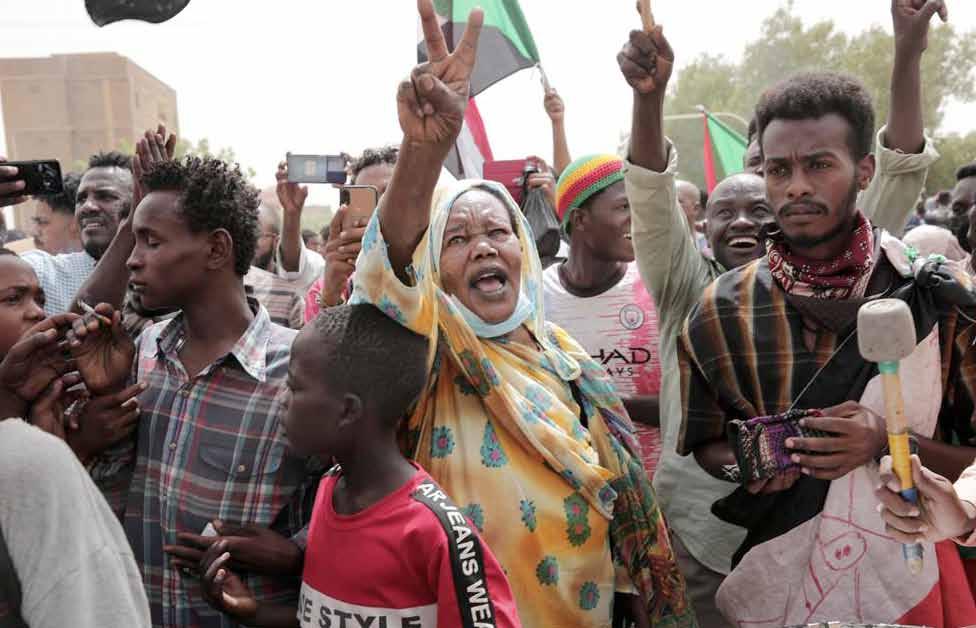
“The Sudanese Armed Forces are committed to distancing themselves from participating in political action and leaving the entire matter to the political entities to reach an agreement that leads to the formation of a transitional civilian government.”
Sudanese burn tires during a demonstration to commemorate the third anniversary of a deadly crackdown carried out by security forces on protesters during a sit-in outside the army headquarters, in Khartoum, Sudan, Friday, June 2022 ,3.

(AP Photo/ Marwan Ali)
in addition to these three explanations previously mentioned together, there is a fourth factor that makes the picture clear er, which is related to the outside world and its role in complicating and escalat ing the situation.
It is no secret that Sudan, in light of the circumstances in the aftermath of its revolution, has become an arena easily penetrated by many international and re gional actors in order to gain a foothold in one of the most important African countries, in terms of its geostrategic lo cation. This makes it entangled with its geographical neighborhood with its cri ses and conflicts or in terms of its wealth and resources that shed further spotlight on the issueit.
Amidst the aforementioned, it becomes important to search for a new approach that will help the Sudanese get out of their crisis and pave the way for a real transitional phase that does not take them back to square one. This recently hap pened after the failure in the post-revo
lution period, during which political ac tion diminished as the military reinforced its power. The international reaction at the level of the United States, European countries, and international organiza tions was against what happened, taking strict decisions in dealing with the Suda nese regime that excluded civilians from power.
However, the issue is much more than just sanctions or penalties imposed on Sudan, because the ones who are im pacted by holding the bumps of these sanctions are the Sudanese people who are groaning under the brunt of poverty, hunger and destitution. These sufferings are, in addition to the chaos brought by the armed conflict that puts at risk the security and stabil at riskity and stirs up tribal and regional conflict once again. All this threatens to pushenter the coun try into a civil war, the extent of which that no one knows its extent or how to get out of.
Accordingly, the proposed approach
stems from two main pillars: the first is the importance of an internal consensus among all Sudanese political parties. The Forces of Freedom and Change are well aware that they are not the only political forces representing the Sudanese people.
There are other political forces present in the political scene and also have proven their presence on the ground, whether the leaders of these forces are inside or outside the country. Perhaps the return of the po litical and religious leader, Mohamed Oth

man al-Mirghani, after a nearly 10-year absence he spent in Egypt, and the size of the mass reception for him by his support ers confirms the validity of the observation saying that any proposed political action must take into account this reality, which includes many active political players.
Moreover, perhaps what Burhan’s state ment denied that the Council had con cluded a bilateral agreement with any party, underlined the importance of tak ing into account the magnitude of the dif ferences among the Sudanese forces and the need to work to bridge the growing gap among them. This bridging repre sents the cornerstone towards building an internal consensus on many foundational issues, starting with the transitional con stitution, the duration of the transitional period, and the form of state administra tion at this stage, as well as the perma nent constitution and the final stage of having Sudan manage its affairs.
As for the second pillar, it is related to the external parties involved in Sudan’s
The ones who are impacted by holding the bumps of these sanctions are the Sudanese people who are groaning under the brunt of poverty, hunger and destitution.Sudan’s head of the mili tary, Gen. Abdel-Fattah Burhan, speaks during a press conference at the General Command of the Armed Forces in Khar toum, Sudan, on October 26, 2021. (AP Photo/Mar wan Ali)
Sudanese anti-coup protesters block a road with burning tyres during a demonstration in the Sharwani Bus Station area of the capital Khartoum, on November 2022 ,8.

(AFP)
affairs, whether at the official level, which is represented by the tripartite in ternational mechanism (comprising the United Nations Mission UNITAMS, the African Union, and the Intergovernmen tal Authority on Development in Africa (IGAD)) concerned with resolving the crisis of governance between the mili tary and civilians, or at an informal level, through the entanglements taking place between some of the external parties and their allies from within Sudan. For this pillar, these two levels need to have a de cisive role in helping the internal parties enhance their understandings to reach an agreement that restores matters to a common starting point in building a po litical system capable of accommodating all Sudanese parties. Otherwise, such a factor would turn into a stumbling block that would obstructs any serious arrange ments that will drivinge the country out of its crisis.
In conclusion, the Sudanese crisis, with its internal complications and external entanglements, will continue to oscil
late between continualous failure and repeated escalation, amidst the competi tion of external parties to achieve gains and prove their presence on Sudanese soil, whether directly through the estab lishment of military bases and affiliated agencies, or indirectly through coordina tion with the internal political and tribal parties. This would, which obstructs any efforts made to reach agreements and understandings that in a way may not be fully consistent with the interests of this or that party.
This is the scourge nibbling on the Suda nese state at the current stage. It is actu ally nibbling on many countries where political forces and societal factions are fighting over the political gains, seeking the help of external parties, and forgetting their responsibility towards their home land and their people to save them from the clutches of internal wars from which the outside will realizereaps its interests whileand the inside loses its security and stability. Will the Sudanese people realize this before it is too late?
 By Salwa Samir
By Salwa Samir
As part of the repercussions of the RussianUkrainian war, Europe is suffering from a severe energy crisis and has come to take strict measures to ration energy consumption.
This is what some considered the only Egyptian gain from this war. Egypt is one of the natural gas producing countries and also generates electrical energy due to its reliance on renewable energy sources from the sun and wind. In addition, some non-traditional sources such as green hydrogen
projects qualify it to become a regional center for the production and export of elec tricity.
Tourism is one of the most important sourc es of foreign exchange for Egypt, besides the Suez Canal, remittances from workers abroad and export. But it has been greatly affected due the Covid-19 pandemic and the Russian-Ukrainian war, as both countries were major sources of a tourist influx.

Egyptian Prime Minister Mostafa Madbouly said in a recent cabinet meeting that Egypt has an exceptional opportunity during the coming winter to attract the largest possible number of tourists, in light of the current global crisis.
The tourism sector contributes 12 percent of the Egyptian GDP and provides 10 percent of jobs.
The Egyptian premier called for the speedy promotion of tourist destinations and target ing more new markets, in an effort to in crease the incoming tourism movement to various Egyptian cities, especially Sharm El Sheikh, Hurghada and Marsa Alam on the Red Sea, as they are “distinguished warm tourist destinations” in addition to Luxor and Aswan.
MP Evelyn Matta told Majalla that she sub mitted a proposal on November 20 to the Parliament’s Tourism and Civil Aviation Committee regarding inviting foreign tour ists to winter destinations like Sharm ElSheikh, Hurghada, Luxor and Aswan, and to reduce their cost of hotel accommodation.
“It is possible to make offers during their stay so that, for example, providing an offer of 3 free days for everyone who books 10 days in any hotel, and another offer of 5 free days for everyone who books 15 days.”
She pointed out that it would be great to pro vide offers that enable them to stay longer, even for a month or two.
The Ministry of Tourism and Antiquities is maximizing Egypt’s tourism benefit from the 2022 FIFA World Cup event in Qatar which is being held from November 20 to December 18. A number of measures have been approved to attract fans participating in this tournament, as those who hold a Hayya fan card are able to visit Egyptian tourist destinations during and after attending the World Cup.
Mostafa Waziri, Secretary-General of the Supreme Council of Antiquities, announced on November 18 that, throughout the period of the World Cup tournament, there is a 50% discount to holders of the Hayya fan card on fees for visiting archaeological sites and mu seums affiliated with the Supreme Council of Antiquities.
The Egyptian Tourism Authority has also taken some steps, including the re-launch of the “Follow the Sun” online campaign, which focuses on the warm winter in Egypt. It asks people to post a video and the one who gets the most ‘likes’ wins a trip to Egypt.
The campaign achieved more than 130 mil lion views in Germany, Italy, the United Kingdom, and the United States. In addition the campaign published news and media re ports about the winter season in Egypt in the international media.
Mohamed Othman, head of the Cultural Tourism Committee at the Egyptian Minis try of Tourism, said last month that Egypt
Tourism is one of the most important sources of foreign exchange for Egypt, besides the Suez Canal, remittances from workers abroad and export.
has witnessed a remarkable recovery in the number of tourists from European countries, especially Spain and France, while Span ish tourism companies are organizing about 48 trips per month to the Egyptian city of Luxor.
A report issued by the Central Bank of Egypt on the performance of the balance of pay ments for the last fiscal year revealed that tourism revenues rose at the end of the last fiscal year to $10.7 billion, an increase of $6 billion compared to $4.9 billion at the end of the previous fiscal year.
The Central Agency for Public Mobiliza
tion and Statistics (CAPMAS) in Egypt an nounced a jump in the number of tourists coming to the country by 85.4% in the first half of this year.
The number of tourists reached 4.9 million, compared to 2.6 million last year, but it is still lower compared to 6.1 million tourists in the first half of 2019.
Tourists from the Eastern European coun tries were the most numerous foreigners to visit Egypt during 2021, with a rate of 50.6%, followed by the Middle East 18.9%, Western Europe 16.4% and Africa 7.1%.

Egypt received the largest number of tour ists in its history in 2010, which amounted to 14.7 million tourists, and revenues that year amounted to $12.5 billion.
The Red Sea Governorate has recently re ceived dozens of international tourist flights, coming from more than 30 countries around the world, most of which are European. At the top of them is German tourism, and with the onset of winter, it is scheduled to increase the rates of incoming flights to the cities of Hurghada and Marsa Alam naturally for the beginning of the winter tourist season.
The Ministry of Tourism and Antiquities is maximizing Egypt’s tourism benefit from the 2022 FIFA World Cup event in Qatar which is being held from November 20 to December 18.Tourists enjoy a meal made by Saqqara residents to improve their living conditions in thier village, in Giza, Egypt, on April 27, 2021. REUTERS/ Shokry Hussien

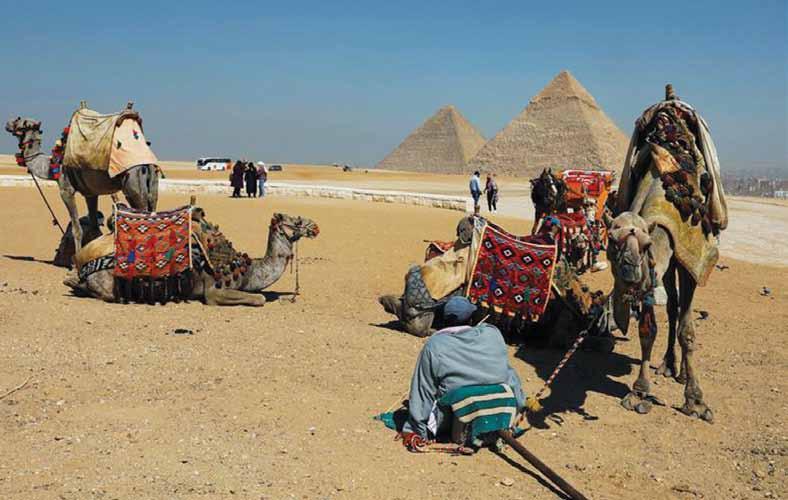
Some civil society and non-governmental asso ciations in Egypt are seeking to make the learn ing process untraditional for children and young people, separate from the traditional methods of education which are practiced at governmental and private schools.
Among those associations are Alwan wa Awtar (A&A) and Safarni, which apply modern meth ods in education with the aim of attracting the attention of children to improve their education al skills through art, photography, observation and critical thinking.
The board chairwoman of Alwan and Awtar association, Azza Kamel, said that “.we offer artistic and non-formal educational activities to children and youth in different urban and rural community areas.”
Kamel said that the aim of the association, based in the Mokattam area in western Cairo, is “to en rich our beneficiaries’ social and cultural wellbe ing as well as encourage them to make the best use of their genius, for the sake of the develop ment of themselves and their communities.”
Kamel told this magazine that Alwan wa Aw tar has drawn up a program for young people to shape their prospects through professional and soft skill development, safe learning space and
non-formal education.
A safe learning environment, flexible learning techniques, performing arts in education and participatory management are key approaches for the success of children during study, Kamel said.
Meanwhile, the Safarni organization, based in Cairo, focuses on opening children’s minds to other cultures. Safarni workshops take children on an imaginary journey to new countries, where they are introduced to the local language, food, games, dances and songs. They have the oppor tunity to meet new people from this country, and interact with them through playing, dancing, and sharing. These journeys open new horizons in the children’s minds and encourage respect for all human beings and cultures.
Safarni has done more than 200 travel days, vis iting countries from all around the world. Safarni dreams of a generation that is globally aware, inclusive, curious and loving, a genera tion that feels connected to diversity and friend ship.
The government has regularly sought to develop the basic education system in Egypt to ensure better learning and skills acquisition.
Alwan wa Awtar ap plies modern methods in education with the aim of attracting the attention of children to improve their edu cational skills through art, photography, observation and criti cal thinking.

Ali Nagui, a Professor of Physical Education at the Faculty of Education, Benha University, stressed the importance of instilling the values of learning to replace the “traditional ideology that reduced the learning process to simply get ting a certificate.”
“There is an urgent need for community dia logue and surveys in the field of education development with a focus on discovering and nurturing talents, as the skilled students are the nation’s engine of progress,” Nagui told Ma jalla.
Nagui said that the government should pay more attention to improving the financial and social status of teachers, as they are the corner stone of the education process.
In the same vein, he spoke about the necessity of physical education to develop the cognitive skills of pupils, especially in early stages.
Physical education provides cognitive content and instruction designed to develop motor skills, knowledge, and behaviors for physical activity and physical fitness.
“Supporting schools to establish physical educa tion daily can provide students with the ability and confidence to be physically active for a life
time,” he said.
The government is keen on developing youth’s innovative capabilities across the country within the framework of localizing the United Nations Sustainable Development Goals (SDGs) and Egypt’s Vision 2030, Nagui went on to say.
Proper physical education at schools should involve checkups, nutritional guidance and de veloping the body with the aim of enhancing performance in class and behavior in public life, as well as encouraging teamwork and social in teraction, Nagui told this magazine.
There is an urgent need of community dialogue and surveys in the field of education development with a focus on discovering and nurturing talents, as the skilled students are the nation’s engine of progress
In the meantime, he referred to the Education Ministry’s strategy to develop the technical education sector with the aim of transforming its curricula to a system based on the skills ac quired by the graduate so that they can meet the needs of the labor market, in addition to presenting the experience of applied technol ogy schools.
“The latest educational upheavals are part of the state’s major national projects that seek to restore Egypt’s pioneering global status as well as its soft power across the Middle East and Africa,” Abdullah Mukhtar, a Professor of Cur ricula and Methods of Teaching at 6th October
University, told Majalla.
Mukhtar highlighted the praise of a number of global educational institutions on the Egyptian experience regarding revamping the education system over the past few years.
He said that more attention should be attached to overhaul the defects of the educational system, stressing the need to rally efforts and join hands to overcome challenges and achieve the best so lutions for problems facing the educational pro cess in government-run schools and universities.
The State seeks to develop the education sys tem and overcome several challenges it faces, according to an ambitious plan that aims to raise the efficiency of schools, integrate modern tech nology into the education process. He said that the Ministry of Education should work more and exert extra efforts to revamp curricula and adopt new education systems that focus on developing students’ skills, he told this paper.
Egypt went from the 72nd position to 53rd place in the 2021 Global Knowledge Index (GKI), coming in first among African states, according to a recent report by the Cabinet media center.
Egypt also advanced three positions in the edu cation ranking issued by US News, in which it came 39th in the 2021 report, compared to 42nd

There is an urgent need to rally efforts and join hands to overcome challenges and achieve the best solutions for problems facing educational process in government-run schools and universities.Unifying values. Students attend a class at the Talaat Harb governme nt primary school in the popular district of Shubra in Cairo. (AP)
in the 2020 report.
The report noted that Egypt moved up 12 places in the technical education and vocational train ing index within the Global Knowledge Index. It came 68th in the 2021 report compared to 80th in the 2020 report.
The Index measures global knowledge as a comprehensive concept closely related to sus tainable development and the various dimen sions of contemporary human life.
According to education expert Mohamed Ha bib, the topography of the basic education and higher education system in Egypt has been “evolving” for the past two decades, with a big push for a major overhaul during the past few years.
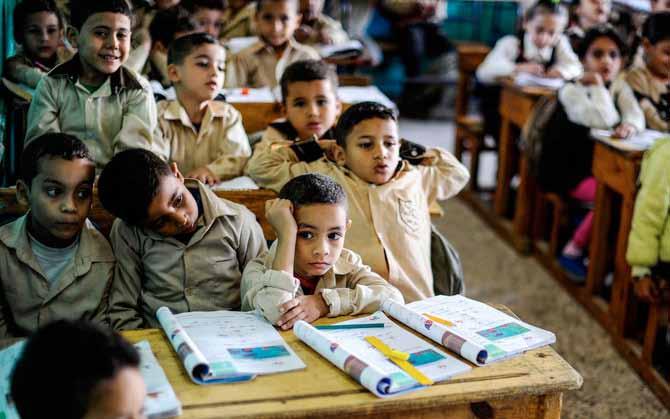
This, he said, had been all but inevitable, nec essary, and overdue, either because new disci plines had to be introduced or because modern ways of teaching needed to be adopted to help graduates properly set out in an advancing, high ly competitive, and extremely demanding labor market.
Today, he said, there is a wide range of high er education options in the country available through 25 public universities, 27 private uni versities, as well as two universities established by agreements with foreign governments, viz., the American University in Cairo, and the Egypt Japan University of Science and Technology.
leadership in Egypt was of the opinion that partnering one way or another with reputable foreign schools and universities could help with upgrading the quality of education. In parallel, there has been a consolidated effort to diversify the options of higher education,” Ha bib said.
He said that teachers are the mainstay for de veloping education. Hence the Ministry of Edu cation is continuously paying more attention to training teachers on the new educational system to guarantee success. Habib hailed TV educa tional channels, describing them as a useful tool to help students and teachers understand the sci entific materials.
“The political
The latest educational upheavals are part of the state’s major national projects that seek to restore Egypt’s pioneering global status as well as its soft power across the Middle East and Africa.


Following in the footsteps of American Bravo TV channel’s “The Real Housewives of Dubai,” last month competitor American Netflix started another series about the lives of a few rich people in Dubai, igniting the same pattern of more criticism and less respect – in both American and Arab media.
According to Netflix, “Dubai Bling” is about a ”highflying social circle in Dubai, where lavish parties, stunning skylines and jaw-dropping fashion are the norm.”
The show follows the lives of men and women from real estate, entertainment industries, in addition to so cialites and influencers. They moved to Dubai from different countries, including Saudi Arabia, Lebanon and Australia. Some of them have those hyphenated – and attractive –identities, like Lebanese-American and Iraqi-American. There is also the fashionable American initial naming, like LJ and DJ Bliss.
According to summaries of past episodes, published in New York-based “Women’s Health, the first one, “Habibi, Welcome to Dubai,” was about “Real estate tycoon Zeina Khoury confronts influencer Farhana Bodi about a past snub; Safa asks her husband for one more closet; LJ goes on a blind date.”
Other episodes were about events like “Farhana throws a birthday bash; DJ Bliss considers buying himself new abs; Safa considers surrogacy; a leak shatters the circle of gossip.”
Under the headline “The runaway success of ‘Dubai Bling’ in the Middle East and beyond,” the Washing ton Post criticized the show for being about a “hand ful of self-proclaimed millionaires living — and quarreling — in the sparkling hub of the United Arab Emirates.”
Thus the two usual sides of American-invented TV series about the lives of rich people: money vs. re spect – and the usual two sides of the viewers’ re sponses: enjoy watching vs. critical evaluating.
On the one side, “Dubai Bling” is an instant hit, and was Netflix’s third-most-watched non-English-lan guage TV show on the week of its release. It also ranks as a network first with Arabic dialogue (with English translations) – as well as a first in the history of American major TV series.
After decades of Arabic shows in the Middle East coming from Egypt and Syria, which are more con servative and male-heavy, “Dubai Bling,” during its first episodes, was the most watched show in Moroc co, Lebanon and Jordan, as well as in all Gulf coun tries, according to Netflix.
But according to the Washington Post, the “wide spread appeal of the show, however, owes less to its cultural introspection and more to all the gossiping and fighting — and the diamonds, oh so many dia monds.”
Sarah Dadouch, the newspaper’s correspondent in Beirut who wrote this, was more critical in her Twit ter page when she wrote: “need someone to write an analytical deep dive on the addictive garbage fire that
is Dubai Bling.”
“Women’s Health” described the show as a “high-fly ing social circle in Dubai” whose life involves “lavish parties, stunning skylines and jaw-dropping fashion,” and “viewers follow these millionaires as they search for money, power, status, and love.”
The magazine quoted a cast member saying: “When I came here (to Dubai), I had $300 which I changed to millions.” The magazine also mentioned that, “Among these millionaires, there’s the real but also the fake.”
“Rotten Tomatoes,” an American website for film and television reviews, recently published ten view ers’ reviews of “Dubai Bling,” and almost all of which were negative.
One wrote: “It’s was over scripted, poorly acted, fake, pretentious and worse than a rotten tomato in a dump ster that is stuck to the bottom and can never be emp tied. Another wrote: “It’s fine if it was fictional. But a reality show? In Dubai without a single Emirati in it it’s like shooting a Californian show with all partici pants from India.”
Again following the reaction to Bravo’s “The Real Housewives of Dubai,” despite its popularity “Dubai Bling” was criticized in both American and Arab me dia.

The Daily Beast, a leading US news and views website, described Bravo’s show as “brutally mind-
numbingly, boring and deceiving.”
Examples: “The sale of alcohol is restricted in Dubai, but champagne and rosé flows in nearly every scene;” the British housewife was angry because she could not do an obscene act during a bachelorette party; the Jamaican-American spent $1,200 to have big blocks of ice delivered to cool-down her swimming pool; and the Kenyan declared: “Whoever comes here, don’t try to steal my stardom because, honey, I’m the star in this city.”
“The Los Angeles Times” wrote: “Bad bitches can throw shade anywhere, even in the desert, and the dumbest show ever is not entirely stupid in its repre sentation of the gulf. And this show is not about war or terrorism. The only Middle East conflict here is among the women.”
The show follows the lives of men and women from real estate, entertainment industries, in addition to socialites and influencers.A still from Dubai Bling.
According to Bet teridge’s law, any headline that ends in a question mark can be answered no. So, I’m glad we’ve cleared that up.
I was shocked to see that the climate change desecrators had been at it again, this time in Madrid. Their latest victim was Goya’s Maja, both the vestida and the desnuda versions. It quickly became clear these were not the kind of iconoclasts who, after blowing up a Buddha, blithely declare “I don’t know much about art, but I know what I don’t like!” The worry for me is that the latter kind are getting ever closer, as the cause grows more hopeless. Hearing about the attacks on Van Gogh and Vermeer was bad enough, but I’ve always kept a special place in my heart for Goya’s rare venture into burlesque. It felt like an escalation. And yet, I really shouldn’t have got so upset. The two girls had stuck their hands to one frame each and then stood slightly to one side, showing the good taste not to interpose themselves between the paintings and the public. They may have struggled to explain their choice of image, but they were careful to leave Goya’s paintings unscathed. Only the frames sustained slight damage.

If I’m honest, I don’t even like picture frames, particularly not the over-elaborate kind, the Rococo style of which is so often at odds with what they frame. In an exhibition of Bonnard some years back, the pictures that lacked frames had an immediate appeal, almost regardless of their quality as works of art, as if they’d burst out of their corsets like Maja herself, assuming she was indeed wearing a corset. The less fortunate works that surrounded them seemed condemned to play ‘before’ to their ‘after’. Actually, though, from a framing point of view, the ‘after’ were definitely ‘before’. I have no desire to cavil, but I found the same difficulty with the frames in the
Cézanne exhibition currently at Tate Modern. Cézanne is a fine artist, I think we can say this with some certainty, but many of his finest works are encumbered by absurdly complicated and oversized frames. In some cases, you wonder if who ever designed these frames was trying to outdo the painting. Here, for instance, is a particularly florid example:
This is a frame that shouts “Look at me!” We can see the fram er’s thinking here, whereby the corners of the frame take on an explosive, cen trifugal quality, lead ing the eye out in four directions, as if to give the viewer some kind of excitement to counterbalance the self-evident dullness and aesthetic clumsiness of the actual painting, with its congealed foreground, un convincing mountain and poorly articulated sky. Sometimes the framer is left with the unenviable task of saving a daub like this from its self-evident artless ness. Or here:
Notice the poorly defined figure with its childlike lack of natural ism, the bench it sits on a mere plank, the surroundings a confusion of unconvincing colours slapped on with no flair or skill whatsoever… all this had to be rescued by the framer from its own shoddiness, with a frame fit for a masterpiece, fashioned and tooled in exquisite detail, a worthy subject for contem plation by the true aesthete.
It’s not impossible that, to this day, framers attend Cézanne exhibitions


purely for the thrill of seeing the artist’s frames. If so, how sorely they would have been disappointed by this one:
A half decent frame could have rescued the situation here. In stead, we see a jumble of inconsequential kitchenware, several apples rendered with barely plausible real ism, and the entire ef fect ruined by a badly drawn green jar that defies the basic laws of perspective and an ticipates the flatness of Matisse and the Cubist experiments of Braque and Picasso. I need hardly stress that this whole situation could have been saved by a beautiful frame, and yet the crudity of the one we see here is laughable, mere straight lines and not a filigree to be seen. What a missed opportunity!
And it gets worse. One painting, near the end of the show, has so niggardly a frame that it threatens to bring the reputation of the whole craft into disrepute. It came as such a shock, I actually lost my balance, hence the wonkiness of the picture:
Again, the artist has attempted to por tray the same moun tain, though to no avail. Judging by the similarity to the first picture, this was a sketch, and the point at which he ought, by rights, to have aban doned the attempt altogether.

But just look at the frame! I found sev eral elderly men tutting around this exhibit. At first, I assumed they were oldfashioned enough to consider Cézanne’s work scandalously inept. On enquiry, however, it turned out they were a visiting delegation of guild-certified framers. For years now, horrified framers such as these have been forced to witness the steady decline in art. They have felt increasingly impotent in the face of instal lations, graffiti and performances, none of which can conceivably be framed, thus nullifying their natural, beneficent instinct to save bad art from itself. The glory days of picture framing ended with the advent of conceptual art: now, most serious artists are the illegitimate sons and daughters of R. Mutt, aka Marcel Duchamp, who ceased to produce art altogether in favour of playing chess with Eve Babitz. The match, incidentally, was won by the glamorous Los Angeles culture vulture, after she played a surprise variation of Bird’s Opening by removing all her clothes.

Of course, I am not suggesting that modern artists are any good at chess. For the same reason as Duchamp, they are unlikely to overcome the distractions of the flesh long enough to become grand masters. What they have inherited from him is a refusal to do art the way artists used to do it.

This may have con tributed to the decline of the very word ‘art ist’. Now, instead, there is a more inclu sive and far more irri tating term for people involved in creative activities. They are known as ‘creatives’.
We might want to ap ply this word retro spectively to Cézanne, though perhaps not wholeheartedly. Traditionally, crea tives of his day still painted landscapes that included people, or nature morte with an attention to detail that went back to the apples painted by Apelles, so convincing that birds came to peck at them. Cézanne had begun the rejection of such values. No vase was truly safe in his hands. It was this destructive potential, subtle as it might appear to us now, that made him a hero for the Cubists, who were outright ‘destructives’. Over the preced ing centuries, painters had developed a symbiotic relationship with framers, the beauty of one craft complementing the beauty of the other, like a happy band of Platonists. Frames had a way of controlling the painting. They were a kind of furniture, after all, halfway to the status of a dado or one of the upholstered couches found in a gallery. By the time Cézanne comes along, we can sense the strain in this relationship, hence the over-compensation by the framers, as if part of a rearguard action as they see their influence wane. It isn’t simply that artists were creating stuff that welched on their side of the beauty partnership. They were beginning to lose interest in creating per se. This can be seen in the readymade, for example, which only required the creative to pick it up and plonk it in the gallery. Mutt was to blame for this particular abdi cation of the artist’s responsibility. It can also be seen in the destructive tenden cies of an artist like Lucio Fontana, who had a habit of destroying his exhibits at the end of his shows. Having moved back to his native Argentina at the start of the Second World War, Fontana returned to Milan to find his studio and all his work had been destroyed by the Allied bombing campaign. This amounted to an enforced tabula rasa. Rather than repeat what had been lost, Fontana pre ferred to start all over again. He began by making holes in his canvases, which he called ‘buchi’:
For years now, horrified framers such have been forced to witness the steady decline in art. The glory days of picture framing ended with the advent of conceptual art.
Ceci n’est pas un artiste
Later, in the Fifties, he began plunging knives into his canvases. He called these pictures his ‘tagli’ or slashes and it’s true, they bore an uncanny resemblance to the modifications the Suffragette Mary ‘Slasher’ Richardson had once made to Velázquez, using a meat cleaver:


Even this type of destruction was never likely to satisfy Fontana. The plane of the picture was still domi nant. He only managed to escape the frame and the formalities of the gal lery altogether with Ambiente Spa ziale a Luce Nera (1948-49), which was first displayed at the Galleria del Naviglio in Milan in 1949. The show only lasted six days and involved a dark room illuminated by a UV light, otherwise known as a ‘black light’.
An abstract, colossal amoeba-like sculpture painted with fluorescent colours hung in the middle the space. Further use of light followed, presag ing the neon writing of Tracey Emin over forty years later, as in this structure from 1951.


With works like this, Fontana demonstrated how far the removal of the restric tive furniture surrounding the artwork could go. Art could do more than merely seep out into the gallery space when the wooden constraints were cleared away. It could actually envelop the viewer and consume an entire room:
These are still works, however. What other descendants of Duchamp have brought to art history is more cerebral. So much so, it very often works better as an idea than a physical manifesta tion. An example of this would be Mi chael Landy’s 2002 solo show entitled Nourishment. This is how his Wikipe dia entry describes the works:
‘The exhibition consisted of a series of detailed etchings of weeds, rendered in the traditional style of botanical draughtsmanship. The intricate detailing is reported to have resulted in lasting eye damage for Landy.’

I missed this at the time, but what a brilliant idea, I thought; I’ve seen so many of these intricate studies in water colour of various plants and their flowers – what a brilliant idea to apply the same attention to detail, but devote it to the plants a gardener seeks to extirpate from their borders. Well, here is one such weed:
This one is called feverfew, ap parently, a flowering plant in the daisy family which may not rank as one of most spectacular adorn ments to a garden, but it has a pretty enough bloom.
Was I justified in experienc ing a twinge of disappointment?
Landy’s version has no colour. The only thing I really like is that he shows us the roots, which give his weeds the pathos of every unwanted, self-seeding plant tugged out of the ground. Nonethe less, if he’d pressed some feverfew between the pages of an encyclopaedia, he could have preserved its colours, its roots and his eyesight.
It was in the previ ous year that Landy had confirmed his credentials as a destructive. In fact, as a self-destruc tive. Break Down, again according to Wikipedia, was the work that ‘put him in the public eye.’
It was staged in an empty clothes store on Oxford Street and was attended by roughly 45,000 people: ‘Landy gathered together all his possessions, ranging from postage stamps to his car, and including all his clothes and works of art by himself and others, painstakingly catalogued all 7,227 of them in detail, and then destroyed all in public. The process of destruction was done on something resembling an assembly line in a mass production fac tory, with ten workers reducing each item to its basic materials and then shredding them.’
The entry points out that Landy made no money directly out of the event and that following it, he had no possessions at all. It neglects to mention whether he went on to join the Franciscan order. The urge to destroy one’s possessions, and by implication one’s wealth, is
Creatives of Cézanne’s day still painted landscapes that included people, or nature morte with an attention to detail, but Cézanne had begun the rejection of such values. No vase was truly safe in his hands.Fontana’s buchi’ Fontana slashes Lucio Fontana Art could actually envelop the viewer and consume an entire room Michael Landy’s weed
atypical of the destructives. It derives from an ascetic impulse and is reminis cent of the story behind Mark Rothko’s Seagram Murals. Rothko, having long before renounced both picture titles and picture frames, produced his ‘mu rals’ to fulfil a lucrative commission from the Four Seasons Restaurant, situ ated in New York’s Seagram Building. Except, they were never installed, and Rothko never received the lucre. Some of the pictures are now on display at Tate Modern in London, others in Japan and Washington, D.C.
It is unclear precisely why Rothko withdrew from the commission when he did, not just because he needed the money, but because it must have been obvious all along that the context for the paintings was an affluent one. He was no great fan of the rich, and from the comments he made on his way across the Atlantic, it would appear he had been painting in a state of rage against them. In conversa tion with John Fischer, editor of Harper’s Magazine, he confessed to a desire to “ruin the appetite of every son-of-a-b***h who ever eats in that room.” He added that he wanted the restaurant’s patrons to “feel that they are trapped in a room where all the doors and windows are bricked up, so that all they can do is butt their heads forever against the wall.” Rothko found further inspiration for the murals in Pompeii’s Villa of the Mysteries and in Michelangelo’s Lauren tian Library in Florence, the vestibule of which “had exactly the feeling that I wanted... it gives the visitor the feeling of being caught in a room with the doors and windows walled-in shut.” In short, the aim seems to have been to create, in the denizens of wealthy New York society, a mixture of dyspepsia and claustrophobia. On his return from Europe, however, he revisited the restaurant with his wife and decided its atmos phere was pretentious and inappropriate for his work. He broke his contract and placed his stomach-churning murals in storage.

A couple of years later, Rothko’s vision would be realised in Buñuel’s The Exterminating Angel, in which the pampered guests are unable to leave a party, owing to an unexplained lack of volition. They get to the threshold and find themselves incapable of leaving.
Silvia Pinal, the lead actress, has said she would ask Buñuel what the film meant, but he would never give a straight answer. When she asked why people entered the house twice, for instance, he replied “Haven’t you ever had breakfast twice or bathed twice in one day?” These Surrealist film directors can be infuriating. She has also claimed that Buñuel invented reality shows, because the people in them cannot leave the room. These actresses in Surrealist films can be even more infuriating than the directors. I hesitate to presume to read Buñuel’s mind, but could it be the rich are unwilling to leave their environment? We see this incapacity in today’s billionaires, with their parties on private islands, or their luxury yachts that never dock for longer than is strictly necessary. Living in a world devoid of poor people is a large part of what being rich is about. Rothko was an anomaly. Artists have usually sought out the company of the rich in order to earn their crust. When they were still creatives, they would serve up
portions of beauty to their rich patrons as a matter of course. They went to a lot of trouble to capture likenesses of the obscenely rich, as beautiful people. De structives, on the other hand, capture the likeness of their obscenity. It’s possible that this is a result of a decline in the taste of artists, but it is far more likely that it bespeaks a decline in their customers. Once, the consumers of art were called Medici and could boast nicknames like Il Magnifico. Now, since the Lehman Brothers, they are no longer considered ‘masters of the universe’ and there’s nothing magnificent about them. Their aesthetic needs, like the animal spirits of the market, are attuned exclusively to profit.
This monetising of taste among the rich meant artists could abandon the idea of beauty as old-fash ioned, a little bit fey, and com pletely played out. Creatives were left without a market and from now on the destructives would win the commissions. No longer required to flatter the appearance of their patrons, they were called upon to flatter their minds, and to do this they reflected the cynicism of the rich back at them, in all its venal splendour. We can see this in the career of Banksy, who began by putting his pictures on the sides of buildings, unbidden, and leaving them to their fate, which was very often to be obliterated by the outraged occupants or local councils. His leftwing views might seem at first to put him on the side of the angels, if Buñuel or Rothko are your preferred archetypes. More recently, however, Banksy has taken to behaving self-destructively in the auction houses, most notoriously in 2018, when his ‘Balloon Girl’ shredded itself after being sold for well over a million pounds at Sotheby’s. The frame of the picture was supposed to destroy the image altogether, to the infinite gratification of the world’s unappreciated (and chronically under-employed) framers, but for some reason the mechanism failed, and the girl with a heart-shaped balloon was only partially shredded. As the Evening Standard rightly speculated, the damage would only serve to increase the object’s value. It is now known as ‘Love is in the Bin’. Banksy had already been at pains to dissociate himself from two of the world’s most celebrated creatives. When speaking about his 2005 work ‘Show me the Monet’ – which was very beautifully, though I would suggest sarcastically, framed – he muttered, darkly:

Not going anywhere: Silvia Pinal tucking in. (The Exterminating Angel)

Art could do more than merely seep out into the gallery space when the wooden constraints were cleared away. It could actually envelop the viewer and consume an entire room.Feverfew Seagram mural
“We don’t live in a world like Constable’s Haywain anymore and, if you do, there is probably a trav ellers’ camp on the other side of the hill. The real damage done to our en vironment is not done by graffiti writers and drunken teenagers, but by big business... exactly the people who put goldframed pictures of land scapes on their walls and try to tell the rest of us how to behave” [my ital ics].
The inclusion of a traffic cone and discarded supermarket trolleys was an unambiguous disavowal of the beauties of the French impressionist:
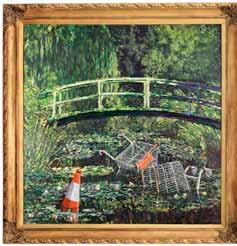
Yet Monet was surely not the only target here. Who, after looking at this work, can deny the contempt of the graffiti artist for framers? It’s in his blood. The art-devouring frame would in fact be just another cruel twist in the inexorable breakdown of the old symbiosis between artist and framer. The latter had been co-opted by a destructive. There was no going back.
As for the rich, the sarcasm of both title and frame was of no consequence. The picture ultimately sold for £6.4 million ($8.2 million).
The world moved on. By February 2021, the bourgeoisie had become accus tomed, as they do, to carnage at the auction house. What Banksy had done was ingenious, but of a piece with the Chapman Brothers defacing Goya prints, say, or Ai Weiwei destroying a two-thousand-year-old vessel.

Determined to move Banksy on from such routine destruction that no longer made a point, some masked men got to work in an undisclosed location some where in Brooklyn. The men were from a company called Injective Protocol and they had bought a print of Banksy’s Morons (White) for $95,000. The print
shows an auction taking place. To the right of the auctioneer, prominently dis played, stands a big ‘picture,’ though there is no image as such, just the words I CAN’T BELIEVE YOU MORONS ACTUALLY BUY THIS S**T. It is mounted on an easel and, as one might expect, has a very heavy gold frame.
So far, so boringly antagonistic towards the art market. But the men in Brooklyn were more dedicated destructives than Banksy has ever been. Coolly and cal culatedly, they set about burning the expensive print, thus adding an extra layer of outrage, and in the process replacing the physical work with an NFT. Their crypto art had the effect of more than quadrupling the original print’s value. Not only were the ‘morons’ prepared to buy this s**t, they were ready to pay more for a digital version. The burning of Morons (White) is thought to have been one of the first times a physical artwork had been replaced by a unique digital asset. “We view this burning event as an expression of art itself,” Injective Protocol executive, Mirza Uddin, told the Guardian (9 March 2021). It was a nice try at sounding intel ligent about a gesture so dumb that Jimmy Carr could have done it on Channel Four. Soon, others would join in, keen to exploit the mysteries of the blockchain to achieve the semblance of gravitas and extract serious money out of the kind of people who make comedians look clever. This was the case in Miami when a businessman called Martin Mobarak, fresh from making a fortune out of bitcoin, took a martini glass filled with rubbing alcohol, held a Frieda Kahlo illustration entitled “Sinister Ghosts” over it and set light to the artist’s work. He then at tempted to flog an NFT of the picture on the basis that it had been ‘transformed to live eternally in the digital realm’, claiming a fraction of the earnings would go to charity. The authorities in Mexico, who consider all Kahlo’s works to be national monuments, objected to this behaviour and began an investigation. Mobarak’s conscience was clear, however. “If Frieda Kahlo were alive today, I would bet my life that if I asked to burn a small piece of her diary to bring some smiles and better quality of life to children, she would say ‘Go ahead and do it. I’ll light the fire.’” The opinion of the deceased artificer was sought before the destruction of this artefact. Similarly, in ancient Egypt it was basic good man ners to ask the pharaoh’s permission before plundering their tomb. Which brings us, with grim inevitability, to Damien Hirst. What, I hear you ask, could possibly have drawn the preeminent Young British Artist’s attention to this shamelessly profiteering stunt? It has to be said, despite dying his hair blue, Damien has looked about as comfortable with his YBA label lately as Martin Amis has looked for the past thirty years with the role of enfant terrible.
An obscene pursuit of dosh was needed to give renewed credibility to his role of reflecting the obscenity of the rich back to themselves. The Currency was the answer: he would burn some of his coloured dots, ten thousand versions of them,
The urge to destroy one’s possessions, and by implication one’s wealth, is atypical of the destructives. It derives from an ascetic impulse and is reminiscent of the story behind Mark Rothko’s Seagram Murals.Terrible waste of a good frame. Banksy’s ‘Show me the Monet’
or else as many as people preferred to keep in the form of NFTs. The Guardian’s Vanessa Thorpe (2 October 2022) seemed barely able to contain her excitement: ‘…an actual bonfire is promised. Hirst is to set light to artworks from his first NFT collection worth £10m. For his critics, the expensive stunt will mark the low water mark in a career built on headlines and brass neck. For admirers, it is a chance to look back at the impact of a master.’ Low water mark? This was more like a fulfilment of the logic behind his entire career. Damien Hirst, as must be obvious by now, has always been a preeminent destructive. In fact, in his old age the most famous Young British Artist has even begun to take his destructive role more literally. As for NFTs themselves, they are the logical culmination of R. Mutt’s legacy, the equivalent of taking up chess, but without Eve Babitz to distract one from winning. Fungibility is so passé. The non-fungible is as close as the digital age comes to the glamour of the original artwork and, better still, it makes the origi nal artwork redundant. Thus, the artists of the future get to annihilate their own fame. A future Lord Byron can protect public morals by torching his own mem oirs. Samuel Palmer can burn all his sketches before his idiot son gets his hands on them. Turner can destroy his erotic pictures before his supposed admirer, Ruskin, has a chance to save Victorian blushes. Kafka can forestall Max Brod and sets light to his own manuscripts. And a future Bulgakov can burn the ‘Mas ter and Margarita’ a second time over. All of them – not just for kicks, but for the sake of life eternal in the digital realm – will be free to reduce their works to ashes and make money the way rich people have always done – since an entrepreneurial caveman first learnt how to make fire – by setting light to the world. As I write, they are raking over the ashes in Sharm el-Sheikh.
For a hundred years and counting, art has become progressively more complicit in its own destruction. But when Chaucer asserted that there was nothing new under the sun, he was quoting. The destructives have actually been there all along, masquerading as creatives. The tendency was present even in one of art’s foremost creatives, Sandro Botticelli, who saw the error of his ways and committed some of his own pictures to the purifying flames. Thankfully, not all of them; the works we see today, hanging from the walls of the Uffizi, were probably out of his reach in the collections of wealthy Florentines, or they too might have ended up on the pyre. This was only able to happen because the Renaissance master’s career coincided with the rule of perhaps the pioneer destructive, a Dominican friar whose name should be synonymous with iconoclasm as his contemporary, Machiavelli’s, is with realpolitik: Girolamo Savonarola.
The Dominicans were a preaching order, and it was through his sermons that Savonarola swung the Florentine population against the Medici and their patron age of the arts, establishing theocratic rule in the city in preference to that of a banking family. This led eventually to the notorious Bonfire of the Vanities, when Savonarola’s zealous followers burned as many of the trinkets and paint ings as they could find.

On this occasion, however, the creatives were destined to conquer the destruc tives, and the man who had chosen the cradle of the Renaissance as a backdrop

for setting light to stuff, ended up being cremated himself. It was a further irony that he should have his death recorded by an artist, albeit an anony mous and not very accom plished one. Also present at the scene were mem bers of the entourage from Botticelli’s Birth of Ve nus. High above the main square of the city, those same vernal winds that had blown her ashore at Cyprus now puffed with all their might to stir the flames under Savonarola:
goddess of love (here reduced to an arm and a leg) watched the triumph of art play out, while her blind son, Cupid, pointed his toy bellows in the direction of the crackling blaze:


They all hovered over head as the preacher and two of his clos est followers were hanged by the neck before being incin erated. Later, under cover of darkness, the executioners dumped the men’s ashes in the river Arno, to frustrate the relic hunters. Sadly, for fans of the great iconoclast, no one had the bright idea of turning him into a non-fungible token.
The frames, and pictures, of Paul Cézanne can be seen in the EY exhibition at Tate Modern till 12 March 2023.
TheEvery World Cup has a standout performer. Pele was a 17-yearold unknown in 1958, Michael Owen in 1998, Ronaldinho in 2002, and James Rodriguez in 2014, after a string of eyecatching performances that earned him the Golden Boot. Even though the 2022 tournament has only been open for two weeks, Pedri, Gavi, Jamal Musiala, Cody Gakpo, Mohammed Kudus, Saud Abdulhamid and Enzo Fernandez have emerged as the new Rodriguez.
The Combination of Pedri and Gavi Highlights Spain’s Strength.
At the FIFA World Cup South Africa 2010, Xavi Hernandez and Andres Iniesta, along with the rest of Spain’s team, took football to new heights. The Barcelona midfielders were the architects of Spain’s renowned brand of possession football, tiki-taka, which captivated the world. Twelve years after that generation’s peak, two other Barcelona midfielders have taken over: Pedri and Gavi.
Spain is led by a couple of teenage sensations who have given the tiki-taka style some punch. Gavi and Pedri, along with a group of other talented youngsters making their World Cup de buts, add speed and energy to the style’s constant rapid passing and ball control.
Along with veteran Sergio Busquets, the only remaining mem
ber of the 2010 World Cup-winning squad, the 18-year-old Gavi and 19-year-old Pedri controlled the pace of the matches. As a teenager, Pedri burst into the spotlight with Barcelona in 2020 and played a key role for Spain at the Euros last summer.
The midfielder has been one of the World Cup’s most im pressive players thus far, running the midfield in Spain’s 7-0 thrashing of Costa Rica and holding his own in a 1-1 draw with Germany.
Gavi, his clubmate, has also impressed in Qatar alongside Pedri in midfield, and Koke praised the Barcelona duo.
“They make magic, and their level is spectacular for their age,” Koke said at a press conference.
Jamal Musiala of Germany Demonstrates His Talent in Qatar Germany’s Jamal Musiala has been dubbed a “future Ballon d’Or winner” on social media following his outstanding perfor mance in the World Cup draw with Spain with fans comparing the Bayern Munich wonder kid to Lionel Messi.
The 19-year-old was instrumental in propelling Hansi Flick’s men to what could prove to be a pivotal point on Sunday, when they fought for their World Cup future in a tense 1-1 draw with Spain.
On Sunday night, Musiala had 84% pass accuracy, 100% cross completion, seven ground duels won, three key passes, and the assist for Niclas Fullkrug’s late equalizer.
And, while the four-time world champions’ performances in
the tournament have been underwhelming, Musiala’s individual performances have highlighted what an exciting talent he is.
The Bayern Munich attacking midfielder, who spent much of his childhood in England but chose to play for his birth country, has been Germany’s shining light in Qatar.
Former Germany captain Lothar Matthaus, on the other hand, believes Musiala is crucial to their chances now and in the future.
Cody Gakpo Equals Cruyff’s World Cup Record With A Goal Against Qatar
Cody Gakpo became the first man in Dutch history to score in the first three games of a World Cup tournament with his goal against Qatar.
The strike, however, did not set the only record made by the 23-year-old at Qatar 2022. He was also the first player in Dutch history to score in the first three games of a World Cup tourna ment.
Gakpo is only the second player in World Cup history to score the first goal three times in the same group stage, joining Italy’s Alessandro Altobelli in Mexico 1986.
The forward also equaled Dutch legend Johan Cruyff’s World Cup goal tally, with both players scoring three goals in the tour nament.
After Wesley Sneijder in 2010, the PSV Eindhoven striker is only the second Dutch player to score with his left foot.
On a soccer field, it can be difficult to determine Gakpo’s true position. On paper, the 23-year-old can play as a number nine or as a left winger. When the space appears, his natural instincts tell him to dive deep and run the channels. Gakpo is a position less attacker.
Gakpo has more goal contributions than Manchester City striker
Last season, the talented PSV striker was named Dutch Foot baller of the Year. Ruud van Nistelrooy, his former youth coach and now head coach, was his mentor, and he hoped to follow in his footsteps at Manchester United next summer.
Star Boy On Fire’s Mohammed Kudus After Ghana Heroics in World Cup
The 22-year-old, who has impressed for Ajax in the Champions League this season, scored twice to help the West Africans to a 3-2 win on Monday, increasing their chances of progressing from Group H. Kudus scored a brace in the 34th and 68th min utes of the game, and he has also assisted.

Kudus was named man-of-the-match, but he remained humble after his performance at the Education City Stadium.
“The whole team was on top of their game,” said Kudus, who has shone for his club Ajax Amsterdam in the Champions
Erling Haaland (23 goals, three assists) and has been one of the most in-demand youngsters in the transfer market, with Man chester United reportedly interested in signing him.“Every World Cup has a standout performer. Pele was a 17 -year-old unknown in 1958, Michael Owen in 1998, Ronaldinho in 2002, and James Rodriguez in 2014.”Jamal Musiala (center) shimmies his way through Pedri (left) and Gavi during Sunday’s match. (Photo Credit: Simon Stacpoole/ Getty Images)
League this season, scoring four goals in six games. His brace makes him the first Ghanaian to score twice in a World Cup finals game, as well as the second-youngest African player to do so, after Ahmed Musa for Nigeria against Argen tina in 2014.

Andre Ayew, Ghana’s captain, said Mohammed Kudus’s star ring performance in Monday’s World Cup victory over South Korea will be known around the world.
Mohammed Kudus has god-like status in Nima. When his name is mentioned in the dense Accra neighborhood where he lives, the locals’ voices are filled with pride. Fans of his club Ajax know him for scoring goals, dribbling, creating chances, and occasionally performing a daring feat on the football field.
During a high-profile junior-level friendly against Powerlines FC, an 11-year-old Kudus carried the team on his shoulders, dominating the game and displaying an innate precision un common in footballers his age. In the end, he scored all six goals as Strong Tower tied their opponents 6-6.
To this day, the memory of the young star outclassing his op ponents on that day in 2011 is cherished in these parts. Real Madrid, the reigning Spanish and European champions, are reportedly keeping an eye on Ghanaian international Mo hammed Kudus after his impressive performances so far at the World Cup.
Saud Abdulhamid is Saudi Football’s Future Saud Abdulhamid brings the same unwavering, strong team work ethic to every team he plays for, whether it’s his current Saudi league club, Al-Hilal, or the Saudi national team.
The Saudi national team wowed the world with a dominant per formance against Argentina in the first match of Group C at the 2022 World Cup.
More than one Saudi national team player shone against Argen tina, but right-back Saud Abdulhamid stole the show early on, despite being in a difficult situation on the grounds of Lusail Stadium.
Saud earned a penalty kick against the Green Falcons early on, and Lionel Messi scored Argentina’s first goal just 10 minutes into the game.
The Saudi national team’s coach, Hervé Renard of France, surprised everyone by starting Saud Abdulhamid against Ar gentina instead of veterans Muhammad Al-Buraik and Sultan Al-Ghanam.
And just when Messi’s teammates thought the young player would be an easy catch after his involvement in the early pen alty kick, and that they would be able to easily fill the Saudi net with goals, Saud showed his true capabilities and was able to shine throughout the match and deny the tango dancers from scoring any playful goal.
After watching Saud Abdulhamid’s brilliant performance as a Saudi defender against Argentina and Poland in the first and second rounds of the World Cup 2022 group stage, three top
“Gavi and Pedri, along with a group of other talented youngsters making their World Cup debuts, add speed and energy to the style’s constant rapid passing and ball control.”
European clubs expressed their desire to sign a contract with him.
Two English clubs and one Spanish club will officially present their offers to Al-Hilal club after the World Cup, with the in tention of contracting with Saud during the winter or summer period if his club accepts their best offer.
Enzo Fernandez, 21 years old, is Argentina’s New Star with A Leader’s Heart Many expected Fernandez to make an impression at some point during the 2022 World Cup in Qatar.

Enzo Fernandez has become Argentina’s youngest World Cup scorer since Lionel Messi in 2006. Last Saturday, the midfielder
scored Argentina’s second goal in a 2-0 victory over Mexico. After receiving the ball from Lionel Messi after a short corner, the Benfica midfielder curled the ball into the top right corner past Guillermo Ochoa.
The 21-year-old Fernandez, a central midfielder who plays for Portuguese club Benfica made his World Cup debut (against Saudi Arabia) despite not having played a single minute of offi cial international football with his country - he was called up for pre-World Cup games in November but did not play.

Fernandez stated after the victory, “I’ve always wanted to play with this shirt since I was a kid, and today my dream of scoring a goal in a World Cup came true. I’m overjoyed with today’s victory; this team deserves it. This victory is for all the peo ple of Argentina who came to cheer us on and all those who are cheering us on from home. This group will best represent Argentinians. We’d like to get one more win, which would be huge for us.”
Everything happened in an instant for Enzo. Enzo was still with the River Plate when Lionel Scaloni took over as coach. In Sep tember 2022, Fernandez made his Argentina international debut as a substitute in a 3-0 win over Honduras.
He attended River Plate Academy. He made his senior debut in 2019 before spending two seasons on loan with another Argen tine club, Defensa y Justicia. Fernandez played for Defensa y Justicia and won the Copa Sudamericana and Recopa Sudameri cana before returning to River Plate and winning the title last year. He joined Benfica in 2022 and has appeared in 13 matches, scoring one goal.
Benfica paid 18 million euros for him last summer, and his con tract included a 120 million euro release clause.
His love for football is unwavering. When he joined Benfica, he hired River’s personal physiotherapist and paid him to look after him every day in Lisbon.
Launching satellites to space is a risky business. The field of orbitally proven vehicles remains small, sensor and payload technology is new and constantly changing, and certain orbital regimes are getting more crowded by the month.

Insurers, of course, are no strangers to risk.
The space insurance industry dates back nearly 60 years. But the past few years have seen a sharp increase in the
number of objects deployed in orbit—as concerns mount about geopolitical tensions in space, weaponization of the domain, and the risks of orbital debris.
The 2022 edition of the Global Risks Report, re leased annually by the World Economic Forum, highlights space as a key risk area. “A greater num ber and range of actors operating in space could gen erate frictions if space exploration and exploitation are not responsibly managed,” WEF notes in its re port. “With limited and outdated global governance in place to regulate space alongside diverging nation
al-level policies, risks are intensifying.”
The amount of debris in orbit—roughly one million pieces over one centimeter in diameter—alongside geopolitical risks and increased frequency of human spaceflight have raised alarms for analysts. Seventy-six percent of respondents to the WEF’s Global Risks Per ceptions Survey said that international risk mitigation efforts in space were either totally absent or in the earli est stages.
Still, insurers continue to underwrite satellite opera tors, braving the high-risk and, often, high-reward space environment. With higher risk, the environment gets tricker to navigate and premiums are more complicated to work out. Nonetheless, industry insiders say there’s plenty of cash to be made in writing smart policies for space players.
In the U.S., launchers are required by law to procure li ability insurance for each mission, covering the launch personnel and the operator.
For satellite operators, though, it’s a different story. “Companies in the U.S. aren’t required right now by the regulators to actually procure any type of liability insur ance,” says Patton Kline, a senior VP at Marsh’s aviation and space practice.
Whether satellite operators are required to buy insurance varies depending on where the company is based. E.U. and U.K. satellite operators, for example, are required by regulators to purchase liability insurance on their satel lites.

On the insurance provider side, space is an opportunity to capitalize on a unique risk environment that’s entirely siloed from conditions on Earth.
“Space is very interesting as a line of business for an insurance company, because it is uncorrelated from any other class of business,” says Denis Bensoussan, head of space at Beazley, a London-based insurer. When natural disaster strikes on Earth, every part of a general insurer’s portfolio can be affected. Space assets are unaffected by terrestrial conditions, so they can pick up the slack when the insurer’s other businesses are making claims.
Geosynchronous satellite operators have a long history of procuring insurance for their satellites. Lloyd’s of London wrote the first space insurance policy in 1965.
In 1967, the U.S., U.K., and Soviet Union opened the
Premiums for space asset coverage have historically been high, reflecting the nascent and risky technology. They can be 10-20x higher than aviation premiums. But between the ‘60s and the 2010s, premiums dropped to ~5-20% of the policy cost, depending on the insurer and reviews of individual systems. Between 2002 and 2019, each year saw a further decrease in premiums (minus a small hiccup in 2007), though the space insurance indus try’s margins grew narrower and narrower.
Things changed, though, leading up to the 2020s. In 2018 and 2019, losses exceeded gross premiums—and in 2019, total losses amounted to nearly $800 million, compared to $400-450 million in gross premium value. “That essentially doubled and tripled premiums in some cases over, really, a very short amount of time,” Kline says.
A few high-profile failures drove the losses in 2019. A Chinese satellite failed to deploy its solar panels in orbit in August, resulting in about $250 million in losses for insurers. A Vega launch failure later on resulted in $414 million in losses—the largest space insurance loss ever. Two other failures led to an additional $200 million in losses. In early 2020, the radio satellite SXM-7 failed, leading to a loss of $225 million for insurers, which many underwriters counted toward 2019 numbers.
At the time, Assure Space, a top space insurer, made waves by announcing that it would no longer cover sat ellites in LEO, except for a few policies that excluded collision coverage.
The insurance industry has reaped a profit on space poli cies each year since 2019 (though it was a close shave in 2020), and premiums have fallen back down to about
“A greater number and range of actors operating in space could generate frictions if space exploration and exploitation are not responsibly managed.”Credit: TNS
5-20% of the policy value. This year, insurance industry capacity is back to pre-2019 levels, driven by new en trants in the space industry.
The satellite insurance market in GEO is well-estab lished. Most owner-operators purchase a standard policy for launch plus one year in orbit, then may renew on an annual basis. It’s a pretty straightforward process, considering the fact that it involves an asset circling the globe at 17,000 miles per hour.
LEO, though, is a much newer market, and most of the technology headed there is newer and has less flight her itage for insurers to look back on. It’s a lot less common to find operators closer to Earth purchasing insurance for their satellites.
“Traditionally, I would say, GEO comm operators usu ally procure launch plus one year in orbit,” Kline says. “For some of the newer operators, for some of the small sat companies or for some of the constellations, a lot of times they’re procuring launch-only coverage. And a lot of times, that’s because they have a lot of satellites up there and they may have redundancy in their constella tion already.”
velopment phase, and they don’t really have the revenue base or clients that need to be protected at this stage,” Bensoussan says.
The differences in modes of financing for GEO and LEO birds also contributes to the likelihood they’ll procure insurance. In general, operators in GEO are older, revenue-generating companies. When an established GEO owner-operator wants to launch a satellite worth $100M+, it’ll finance that project by raising debt. Lenders generally require as part of the terms of financing that operators insure the cost of the satellite.
“Banks are very conservative,” Bensoussan says. “They want to make sure that the asset is protected. And if the asset fails, they want to get compensation from the in surance.”
Broadly speaking, though, LEO operators tend to be venture-backed and newer to space (and have yet to dis cover solvency). They’re acting with a build-fast-andbreak-things mindset, and the investors financing those projects are more willing to accept the risk that things might break after launch.
“LEO operators are mostly using venture capital mon ey,” Bensoussan says. “And venture capital money has a different appetite toward risk, or technical risks, than banks.”
It’s all about risk tolerance. If an operator is building a LEO megaconstellation, chances are they’re expecting a handful of them to fail, so taking out insurance on each individual satellite doesn’t make much sense. These in dividual satellites are also far cheaper to produce than large GEO buses, so if a few don’t work, the losses are minimal, relatively speaking.
“Most of the players in LEO are either new or in the de
To an extent, premiums are linked to flight heritage, reli ability, and underwriter reviews.
If you’re launching a satellite on a rocket with a longer history of success, the insurance premium as a propor tion of the total policy will be lower than if you’re flying with a newer, less proven rocket.
The International Space Station (ISS) photographed by Expedition 56 crew members from a Soyuz spacecraft after undocking, October 2018 ,4.NASA/ Roscosmos/Handout via REUTERS At
Same goes for satellite premiums. Experienced under writers go through a detailed review of new satellite sys tems before determining premiums. If a satellite is using proven systems with flight heritage, its premiums will be lower than an experimental satellite that an underwriter deems more likely to fail.
Determining premiums doesn’t just hinge on an individ ual system’s successes and failures, but also on the space industry as a whole. If, as in 2018 and 2019, a series of insured launches fail and those operators submit claims,

then the insurance industry will have to raise premiums across the board to offset losses.
Launch tests are often not insured at all. If they are, they’re typically insured under small policies. Ameri can operators tend not to insure their experimental sat ellites at all, and operators in higher-risk environments like LEO also frequently forgo insurance. About half of all new satellites are insured.
Premiums now are sitting at ~5-20%, depending on a number of factors including heritage and maturity.
We often say that the space industry is at an inflec tion point. In the coming years, the industry expects the gravy train to keep rolling. Launches will get more and more frequent, new medium- and heavy-lift rockets will come online, and tens of thousands of new satellites will take up residence in Earth’s orbit over the next decade.
The space insurance market is poised to change, too. Bensoussan says that as the LEO market matures and be gins generating revenue, operators will eventually have

to warm to the idea of buying satellite insurance.
“It’s a sort of learning curve, and most of the players have not matured yet to the point where insurance is be coming . . . a necessary step they need to take,” says Bensoussan. “We’re going to see much more demand for insurance from the LEO world, but I think it would take us to adapt to the new paradigm in LEO.”
This article was originally published by Fast Company.
“With limited and outdated global governance in place to regulate space alongside diverging nationallevel policies, risks are intensifying.”
What does an eating disorder look like? Likely to spring to mind is a young, waiflike woman strutting down a catwalk, bones protruding under her clothing. Yet her older sisters aren’t immune to anorexia, bu limia, and binge eating. Weight-control efforts veer into dangerous territory in more women at midlife and beyond than popular images suggest.
It’s no secret that most of us have dieted at some point -- some of us on a regular basis -- but women
can face unique stressors as we age that increase our risks of eating disorders, Harvard experts say. The rigors of calorie restriction or binge-purge cycles on an older body, in particular, can also lead to worsened health effects.
By age 40, one in five women has dealt with an eating disorder, twice the proportion identified in women at age 21, according to a 2019 study in JAMA Network Open. Many cases are likely a resurgence of a longsimmering pattern from earlier years that may have flown under the radar, says Dr. Holly Peek, associ

ate medical director of the Klarman Eating Disorders Center at Harvard-affiliated McLean Hospital.
“Many women with eating disorders in midlife have had the problem for most of their lives,” Dr. Peek says. “And a lot are going through major life tran sitions starting around age 40 that are all different from those of a teenage or young woman.”
Disordered eating that barely skirts the line be tween normal and problematic is also highly com mon, more so than diagnosed eating disorders. “Up to midlife, it could look like chronic dieting, yo-yo dieting, or excessive exercise. Sometimes women get wrapped up in this identity of being a gym rat who eats very clean, and menopause-fueled body changes make them ramp it up even more,” Dr. Peek says. “It may not even feel like a problem to them. It gets re ally complicated.”

Many variations of eating disorders are possible, but three types dominate: anorexia nervosa, characterized by extreme food restriction; bulimia nervosa, gorg ing followed by purging through vomiting or laxative use; and binge eating disorder, eating huge amounts past the point of feeling full.
Anorexia becomes less common after age 26, but bu limia rates don’t top out until age 47, according to a November 2017 study in the International Journal of Eating Disorders. Meanwhile, binge eating disorder -- the most common eating disorder in all adults -can continue to be a problem for women in their 70s.
What fuels such pathologic preoccupation with food and weight through the decades? Midlife and older women may be trying to stay competitive in the workplace, where thinness may be associated with youth, or re-emerge on the dating scene after divorce or widowhood. The jolt of an empty nest may also propel body-redefining efforts.
“The importance of body image seems to be a key feature that makes women either return to or start an eating disorder,” says Dr. Bettina Bentley, a primary care physician at Harvard University Health Services. “With aging, many women are also disturbed by the lack of control over the ways their body is changing.”
Indeed, estrogen shifts related to the menopause tran sition can heighten eating disorder risks. “We know that estrogen plays a role in developing an eating dis order on both ends of the age spectrum, but in terms
of why, the jury is still out,” Dr. Peek says. “Women during menopause are more likely to gain weight, and you may feel your body is working against you.”
Extreme weight loss is a clear sign someone may have an eating disorder. But how else might you spot this condition in yourself or others? Look for
- dramatic weight fluctuations, whether up or down - preoccupation with weight, calories, and body size and shape
- refusal to eat certain foods or categories of foods (such as sugar or carbohydrates)
- excessive exercising
- skipping meals or eating only tiny portions at regu lar meals
- food rituals, such as excessive chewing or not al lowing different foods on a plate to touch
- signs of purging behaviors, such as frequent bath room trips, vomiting sounds or odors, or laxative wrappers
- lots of empty food wrappers or containers within short periods.
“Anytime these thoughts and behaviors are taking over your life, it’s a sign to seek help,” says Dr. Holly Peek, associate medical director of the Klarman Eat ing Disorders Center at McLean Hospital.
Even when invisible to others, eating disorders can take a toll on the body. At a minimum, women with eating disorders are often deficient in some nutrients, particularly iron, vitamin B12, calcium, and vitamin D, says Margaret Schrier, a registered dietitian and head of nutrition at Harvard University Health Ser vices. “Supplements can help with deficiencies and are usually well tolerated by patients,” Schrier says.
Disordered eating that barely skirts the line between normal and problematic is also highly common, more so than diagnosed eating disorders.Credit: (TNS)
She advises taking them with food, since they may not be absorbed as well on an empty stomach.
Extreme weight loss, purging, and malnutrition can also lead to these problems: Bone loss. The risk of bone fracture is seven times higher in someone who’s had anorexia than in the general population, Dr. Bentley says. While bone density testing isn’t routinely recommended for women in their 50s, she orders it for those she thinks might have an eating disorder as well as those who’ve broken bones.
Heart problems. Lower electrolyte levels from disor dered eating can lead to an irregular heartbeat. Wom en in midlife are also more likely to take medications for chronic conditions, which can increase this risk. “It’s more of a recipe for a medical emergency, be
cause your body just isn’t as resilient as when you were 16,” Dr. Peek says.
Lung conditions. Chest muscles become weaker over time, especially in people who repeatedly force them selves to vomit. This raises pneumonia risk. Gastrointestinal issues. Reflux, bloating, nausea, vomiting, constipation, or diarrhea may be dismissed as consequences of aging but instead may be related to an eating disorder.
Diabetes. People with binge eating disorder have far higher rates of diabetes, likely fueled by frequent blood sugar spikes after gorging, Dr. Bentley says.
Skin breakdown. Poor wound healing and profound facial wrinkling is common in people with longstand ing anorexia, Dr. Bentley says. This probably reflects overall poor nutritional status.
While eating disorders claim more lives than any other type of psychiatric illness, only 27% of those affected seek professional help. A team of health pro fessionals that include a dietitian and therapist can help shepherd patients to better physical and mental wellness. If you suspect you have an eating disor der, don’t be afraid to have a frank conversation with your doctor. She is trained to assess and treat eating disorders as she would any other medical condition, without judgement.
This article was originally published by Harvard Women’s Health Watch.

By age 40, one in five women has dealt with an eating disorder, twice the proportion identified in women at age 21, according to a 2019 study in JAMA Network Open.Credit: OcusFocus


Morocco’s resounding victory over Bel gium in Sunday’s FIFA World Cup match enthralled fans at Al Thumama stadium and around the world. The most emotional scenes in the stands occurred when Mo roccan player Achraf Hakimi went over to kiss his mother.
Achraf Hakimi, visibly moved, was seen hugging his mother, Saida Mou, in the stands. Saida Mou is a mother who is cred ited with inspiring her son’s success. After the win, the PSG player, who pre viously played for Real Madrid and Inter Milan, dashed to the stands. He also gave his mother his match shirt. The emotional scenes’ video and photos have gone viral on the internet. Hakimi himself posted pic tures on Twitter.
It has a heartwarming backstory. Ashraf’s mother, Saida Mou, used to clean houses in Spain in order to provide a better life for her son. Her husband worked as a vendor on the street.
“My mother was a house cleaner, and my father was a street vendor. We come from a low-income family that struggled to make ends meet. Today, I fight for them every day. They gave up their lives for me. They took many things away from my brothers in order for me to succeed,” Achraf Haki
mi once told Bundesliga.com. Hakimi, who was born in Madrid and could have played for Spain, chose to rep resent Morocco because of his parents.
On his decision to play for Morocco, he told Vogue, “In Paris, you play for the city team, but it’s not the same to play for your country. Millions and millions of people will rally behind you because you play for them. It’s almost as if you’re playing for your grandfather and their grandfathers. You play for a large number of Moroc cans.”
Hakimi represented Morocco at various youth levels before making his interna tional debut in 2016 at the age of 17, hav ing previously been capped by the nation’s under-20 teams. He was named to Moroc co’s squads for the 2018 and 2022 FIFA World Cups, as well as the 2019 and 2021 Africa Cup of Nations.
Hakimi was a product of Real Madrid’s youth system. He joined Real Madrid Cas tilla in 2016 and was promoted to the first team in 2017, where he played a few min utes. He was loaned out to Bundesliga club Borussia Dortmund for two years, winning the DFL-Supercup in 2019.
Following a successful loan with Dort mund, Hakimi joined Serie A side Inter Milan for a reported fee of €40 million, with his performances assisting the club in winning the league title, ending the club’s eleven-year title drought. His per
formances piqued the interest of several European clubs, with Paris Saint-Ger main reportedly paying €60 million to sign him in 2021.
Hakimi signed a five-year contract with Ligue 1 club Paris Saint-Germain (PSG) on July 6, 2021. The Guardian reported that PSG paid an initial €60 million transfer fee, which could rise €11 million in add-ons. On August 7, 2021, Hakimi made his Ligue 1 debut for PSG, play ing the entire 90 minutes and scoring his first goal for the club against Troyes. On August 24, 2021, he received his first red card in European football in a 0-0 draw against Marseille. On September 22, 2021, Hakimi scored twice in a 2-1 vic tory over FC Metz to give his team a win and three points.
When he signed for Borussia Dortmund, Hakimi was profiled as a quick, dynamic, and powerful right-sided attacking fullback or wing-back who is tactically and technically adept and capable of playing long accurate passes from defense. He was trained as a winger, but due to his physical presence, he can also play as a defender. Several pundits consider him to be one of the best defenders and right-backs in the world.
Hakimi is married to Hiba Abouk, a Span ish actress of Libyan and Tunisian descent. The couple has two sons due in 2020 and 2022. He is an ardent Muslim.


At the hand of Chairman Deng Xiaoping, China finally opened its economy in 1979 to foreign investment and technology, normalizing trade with the US and becoming the factory of the world, which led to rapid growth. China was seen as an opportunity but has now turned into a threat. The most hostile steps taken against this new threat to US political and economic hegemony were initiated in 2018 by Trump by setting up tariffs. The policies of Trump regarding China have been kept in place. On top of that, President Biden›s administration decided to restrict exports of equipment and services required by China to produce semiconductors. This article will explore the story behind the hostility in depth.
The US government stated several reasons for starting the trade war, such as labor and human rights violation, currency manipulation, unfair subsidization, stealing technology etc. However, we all know the main reason, which is the threat of China becoming the largest economy and military power in the world and with it gaining many political advantages. This reason is also known as “national security concerns.” Hostility was rising even before Trump wielded his policy, and Biden is just following his predecessor’s footsteps. The US aims to restrict China from developing advanced node semiconductors, semiconductor production equipment, advanced computing capabilities, and supercomputers, all crucial technologies. The research tank PIIE states that the US plans to restrict China “through novel uses of lists of controlled items, through controls on activities by US persons, and extraterritorial reach concerning foreign-made items going to specific Chinese companies.” Specifically, “The policy restricts US exports of the top-of-the-line tools made by American companies from going to facilities in China making semiconductors.”
All this effort is to stop Chinese companies such as SMIC from producing and developing advanced semiconductors, which would lead to significant advances not only for commercial uses but also for military purposes. As the national security advisor articulated: “On export controls, we have to revisit the longstanding premise of maintaining relative advantages over competitors in specific vital technologies. We previously maintained a ‘sliding scale’ approach that said we need to stay only a couple of generations ahead.” In summary, if the US is ahead, they are tolerant, which hints at the nature of globalization and free trade slogans.
However, the effectiveness of US policies depends on two allied countries, the Dutch and Japanese governments. This is because Tokyo Electron in Japan and ASML in the Netherlands both facilitate the Chinese production of semiconductors. Hence as stated by the chief executive of ASML, the US was “putting a lot of pressure… to make sure that the Dutch government and the Japanese government follow as well.” The Dutch Minister for Foreign Trade stated that they will defend their interests. As such, they will not follow with the USA unless its loss is compensated politically or monetarily.
China cannot make advanced semiconductors without the goods and services provided by the USA, Japan and the Netherlands. Even if Japan and Netherlands don’t follow suit, US sanctions would be extremely harmful. The Chinese government is not the only one suffering but also the US companies. However, this won›t significantly impact major users such as Jack Gold, an analyst at J. Gold Associates, who noted, “restrictions are mostly focused on the very advanced chips. Other high-volume chips are not restricted and will flow as they do now.” As a result, the majority of users will not notice.




























